

10 Most Famous Ship Paintings
One of the most iconic painting niches in the world is that of ship paintings. For centuries, the world’s seas were dominated by various nations who sent trading vessels and warships out into the blue horizon.
Over many years, these ships became the lifeblood of the economies of certain countries like Portugal and Great Britain, their crews bringing and delivering precious cargo of all kinds.
Ships of all shapes and sizes have sailed the seas for more than a thousand years. The juxtaposition of a sophisticated man-made ship with the unpredictable and dangerous nature of the ocean and Mother Nature itself is part of what draws the admiration of so many art lovers and enthusiasts, especially along coastal regions.
Many artists throughout history have dabbled in producing works that featured ships and their legendary voyages on the high seas with some focusing solely on the subject of maritime travel. Here are some of the most famous ship paintings ever created.
Famous Ship Paintings
1. the fighting temeraire tugged to her last berth to be broken up – j.m.w turner.
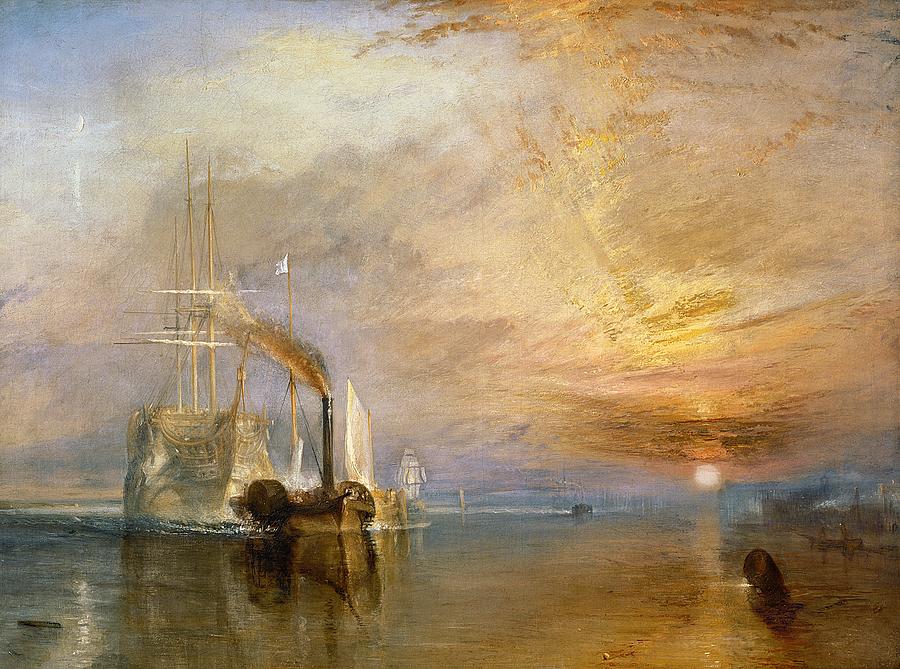
One of J.M.W. Turner’s most famous paintings involves a well-known warship that was the star of at least one iconic battle for the British Royal Navy in the 18th century. His work is titled The Fighting Temeraire Tugged to her last Berth to be Broken Up, a lackluster, but fitting description of the fate of this once feared vessel that was pivotal to the nation’s fleet of warships.
The painting was done in 1839 and depicts the final moments of the Temeraire as it is slowly tugged out to sea to be dashed and parted out.
The painting is from the Romanticism era and is an interesting contrast between the changing technologies that were happening in maritime shipbuilding and travel during the early 1800’s.
The majestic and once-famous warship, who played a major role at the Battle of Trafalgar, is now being dragged away from port by a lowly, steam-powered tugboat.
It is a sad reminder that a certain sense of elegance and grandeur is often lost in what many deem to be a progressive advance of technology.
2. A First Rate Man-of-War Driven Onto a Reef of Rocks, Floundering in a Gale – George Philip Reinagle
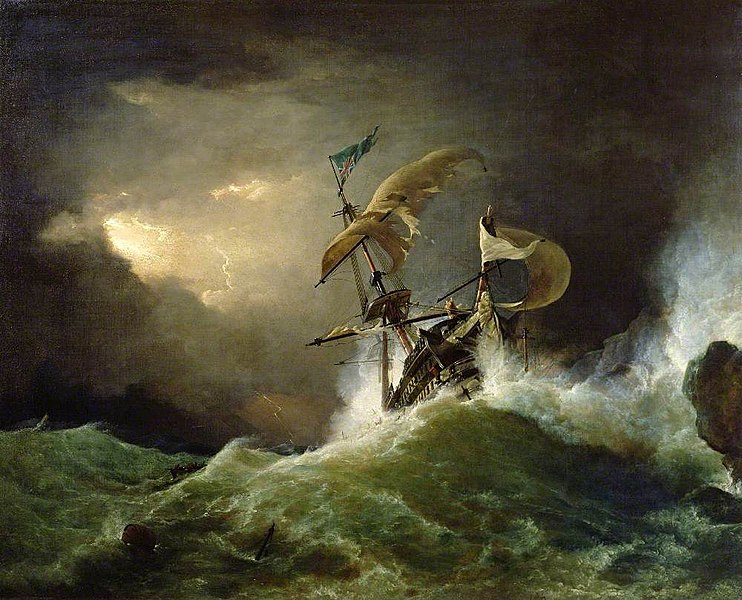
The early 1800’s is likely the height of the era of famous ship paintings. One of the most well-known maritime painters was George Philip Reinagle, who was well-known for his ability to capture the essence of the sea’s sometimes tumultuous character that had destroyed so many powerful, strong vessels throughout history.
His 1836 work titled A First Rate Man-of-War Driven Onto a Reef of Rocks, Floundering in a Gale is aptly-named as it features just that—a ship that has been caught in the clutches of the raging sea.
One of the most intriguing aspects of maritime travel was the possibility that sailors could meet a terrifying demise if they were caught in a blustering storm, otherwise known as a gale.
This painting is iconic for Reinagle’s ability to depict the giant, crushing force of the waves along with the sea spray that has been kicked up by the high winds. This work is a grim reminder that not all seafaring travel and adventure ends safely.
Many ocean paintings containing ships will invariably make the ship the main focus, but in Reinagle’s piece it is the power of the ocean waves that dominate.
3. Battle of Trafalgar 1805 – Louis Phillipe Crepin
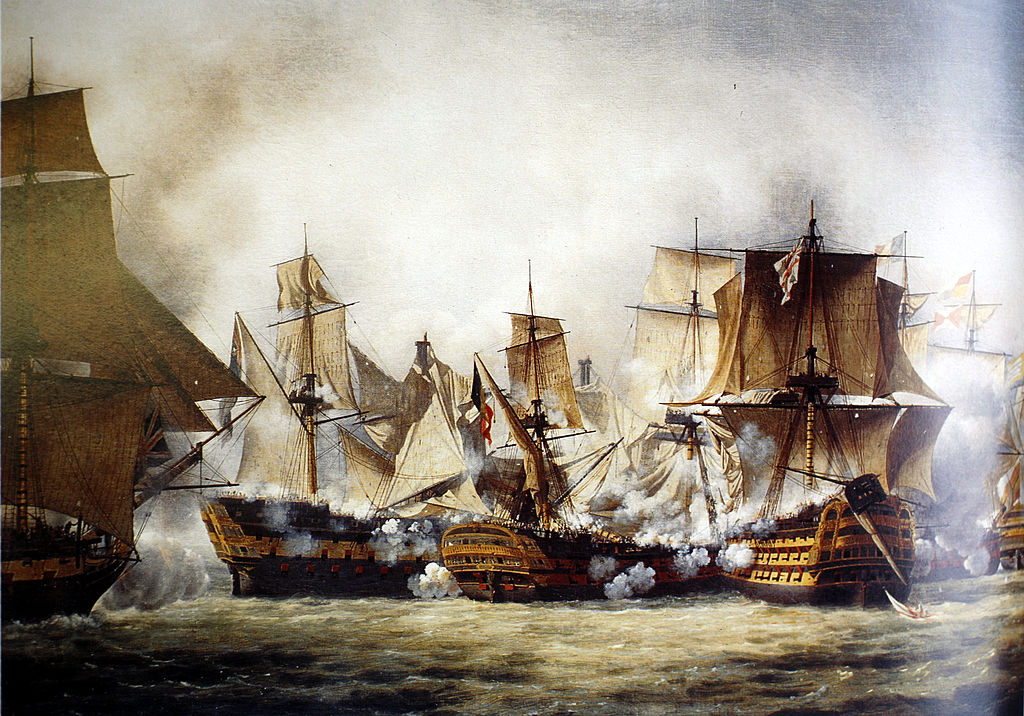
Some of the most famous ship paintings involve intense, deadly battles at sea between powerful naval fleets. Such is the case with Louis Phillipe Crepin’s 1805 work titled Battle of Trafalgar.
This painting depicts one of the most famous naval battles in history that took place in the year noted.
The Battle of Trafalgar featured the mighty British Royal Navy as they were pitted against two other worthy opponents—the Spanish and French naval forces—who had joined forces to try and topple the powerful force that had dominated the waters surrounding Europe and much of the world during this time.
Crepin’s painting portrays, with great accuracy, the close-quarters combat that so often occurred in naval battles.
4. Snow Storm – Steam-Boat off a Harbour’s Mouth – J.M.W Turner
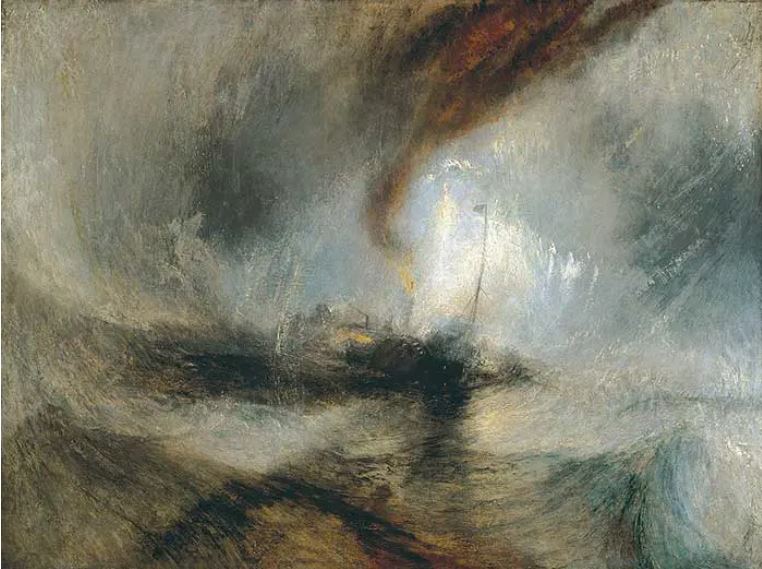
As noted above, J.M.W. Turner was among the most famous artists who focused on the life and voyages of sailors and their ships.
Many times, these voyages were undertaken during powerful, unpredictable storms that all-too-often led to the ships capsizing and the entire crews being lost.
Turner’s 1842 work titled Snow Storm – Steam-Boat off a Harbour’s Mouth is one such painting that depicts the sea’s ability to make any vessel, large or small, feel the power of its might from time to time.
Also Read: Famous Lighthouse Paintings
The painting features the steam boat ship caught in a frigid snow storm , the wind sweeping and whipping in every direction as the ship struggles to stay on course and avoid succumbing to the massive waves.
According to many art historians, Turner went to great lengths to accompany various ships’ crews on their journeys so that he could paint his works as accurately as possible.
5. Becalmed off Halfway Rock – Fitz Hugh Lane
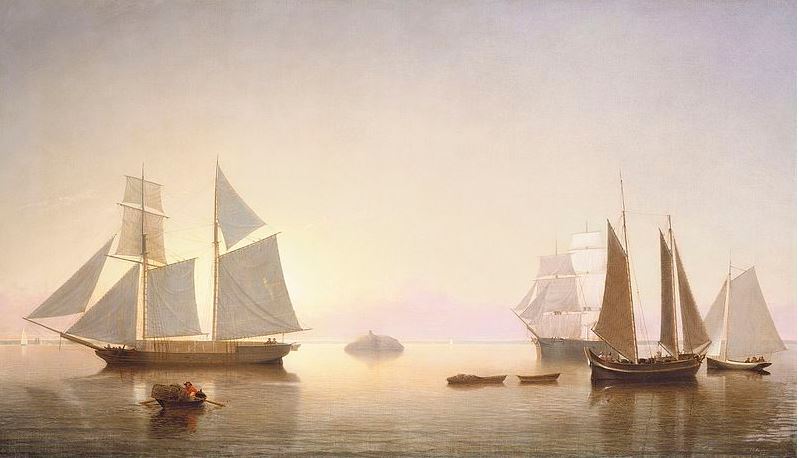
So many of the most famous ship paintings ever created feature vessels that are either engaged in raging battles, or caught in powerful gales on the open ocean. However, there are a few notable works that depict the calm, serene nature of the ocean or coastal areas.
Fitz Hugh Lane’s Becalmed off Halfway Rock is one such work that depicts a scene of beauty that few people outside the world of ships and sailing ever get to experience.
This 1860 work depicts ships anchored down next to Halfway Rock, a famous sea marker that is situated approximately halfway between Boston and Cape Ann.
This marker was a popular stop for trading vessels and supply ships as they could join up with other ships and carry out various types of maritime business at a specific location.
Lane’s work features a number of ships anchored down with small row boats working their way from one to another, likely swapping various cargo and other items.
6. Dutch Men-O’-War and Other Shipping in a Calm – Willem van de Velde II
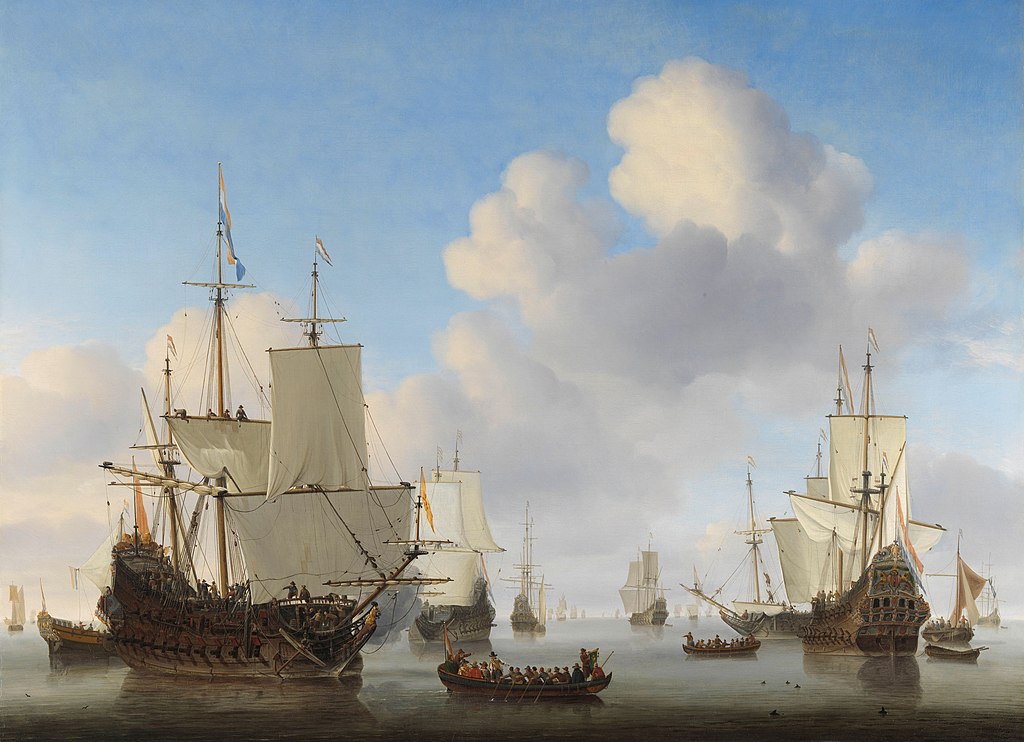
Willem van de Velde II was a painter who specialized in maritime art during his career in the late 17th century.
This was a time when sailing ships were the height of mankind’s technological achievements and the naval fleets of various nations were the most vital part of any military force.
Velde’s work titled Dutch Men-O’-War and Other Shipping in a Calm was created in 1665 and features the Dutch navy’s vast fleet of ships that include the deadly and feared Men-O’-War vessels.
These ships were known as floating fortresses who possessed the ability to mercilessly pummel opposing ships or coastal forts and cities with impressive precision.
7. The Home Fleet Saluting the State Barge – Jan van de Cappelle
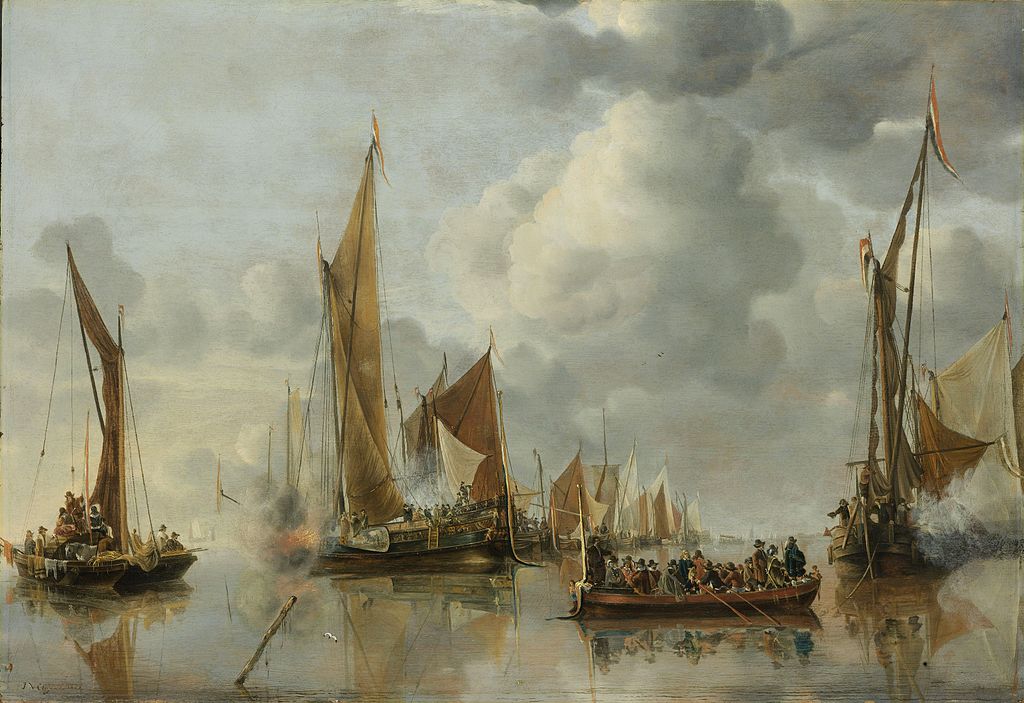
The mid-1600’s was a time in which maritime travel was responsible for reshaping the people and nations of the world as many pilgrims and travelers ventured to the New World across the Atlantic Ocean.
Jan van de Cappelle captured one instance of significance from this time period in his 1650 work titled The Home Fleet Saluting the State Barge.
The painting depicts a number of different ships gathered together in a port to salute a prominent vessel as it embarked on its voyage.
Cappelle’s work is one of the most well-known ship paintings in history as he masterfully depicts the water’s ability to mirror the happenings above its surface with stunning detail.
8. Argenteuil (Red Boats) – Claude Monet
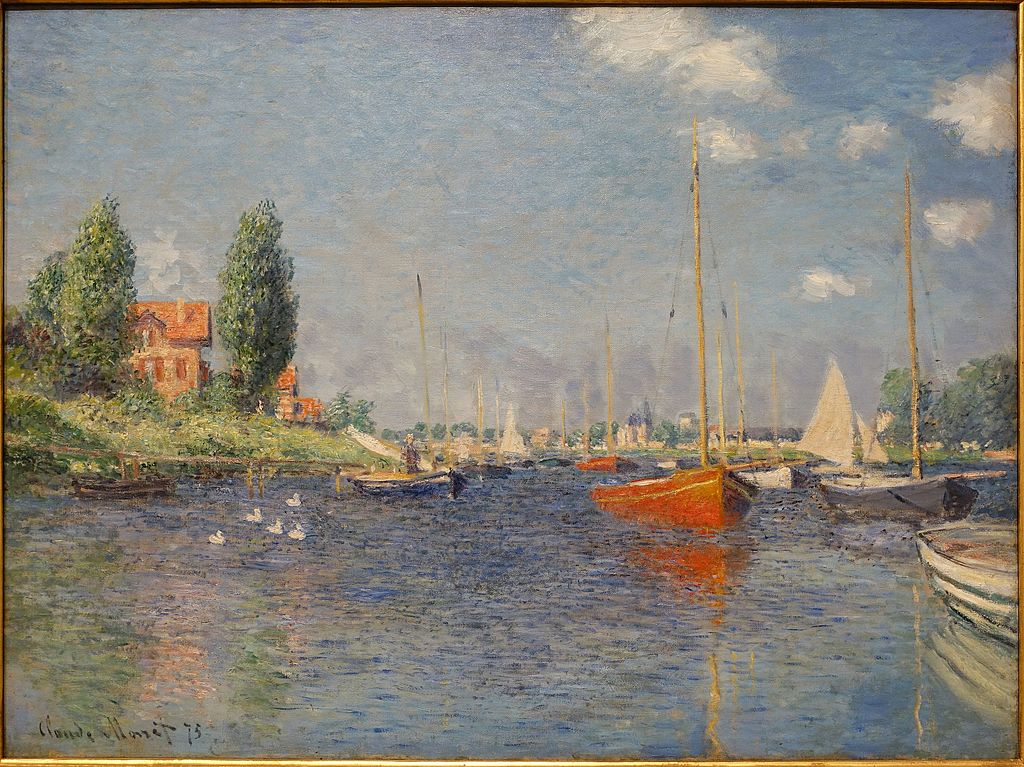
Claude Monet is celebrated as one of the most famous impressionist painters , but most of his work featured scenes from dry land instead of ships and maritime travel. However, his 1875 painting titled Argenteuil (Red Boats) is among one of the most recognized ship paintings ever created.
This work features Monet’s trademarked Impressionist painting style and depicts a calm scene that features contrasting colors that truly highlight the boats in the center of the canvas.
The smooth water appears almost like glass in its ability to reflect the boats and their towering masts.
Monet’s brushstrokes vary greatly when one focuses on the sky above the water and the boats, which are crafted with short, choppy strokes that are able to convey great detail.
9. Nelson’s Inshore Blockading Squadron at Cadiz – Thomas Buttersworth
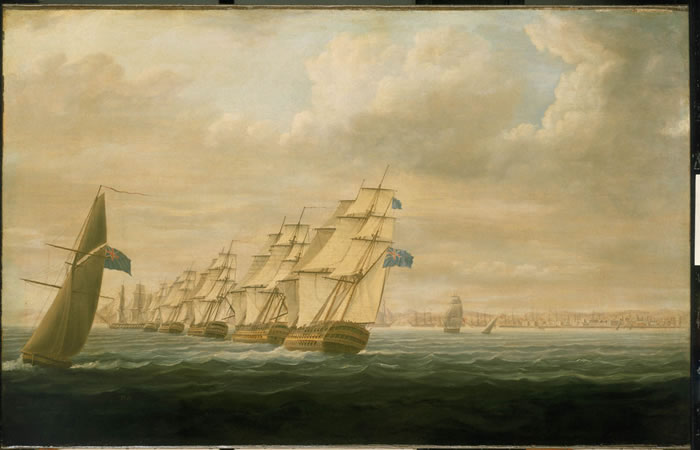
The British Royal Navy was at the peak of its seafaring prowess across much of Europe and the rest of the world during the latter half of the 18th century.
The nation’s powerful fleet engaged in many battles along the coast of Portugal during this time as the two countries were locked in a bout to control the waters around coastal Europe and other parts of the Atlantic.
Thomas Buttersworth painted a work in 1797 that is a testament to a great naval battle for the British forces off the coast of Lisbon. Following the famous Battle of St. Vincent, rear-admiral Nelson and 10 bargemen were engaging in a raid on Spanish gun-boats under the cover of darkness.
The Spanish commander realized his boats were under attack and launched an effort to defend them with 26 of his own men. Despite the British being heavily outnumbered, they managed to kill 18 Spanish sailors and capture the remaining few after a bloody sword fight ensued.
Buttersworth’s painting is a testament to that incident that was a historical victory for the British Navy.
10. Breezing Up (A Fair Wind) – Winslow Homer
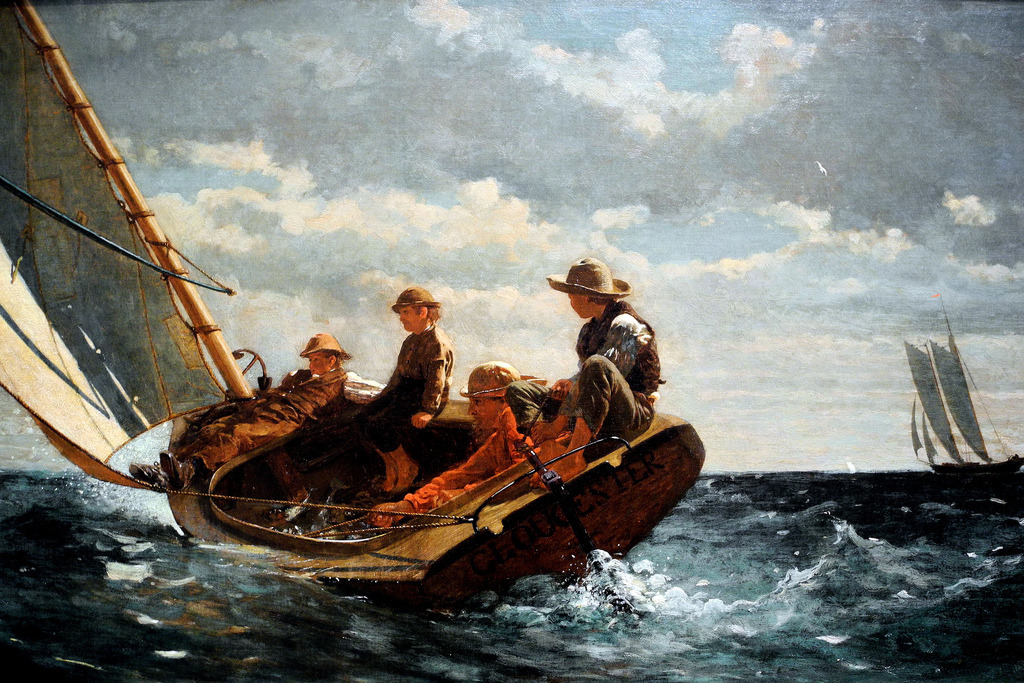
One of the most iconic American paintings of all time was done by Winslow Homer, who was another artist that was well-known for his maritime paintings.
His 1876 painting titled Breezing Up (A Fair Wind) features a highly-detailed scene of a small sailboat cruising along on the waves as the sun is at the backs of the men and boys aboard the boat.
In the painting, the boat’s sail is clearly filled with what many would consider to be a ‘fair wind’ as it leans heavily toward the water while the boat’s rudder is steered toward their destination.
The painting is meant to depict a common scene from the late 19th century America as sailing was one of the most popular means of travel around coastal New England at this time.
The work is known for Homer’s masterful use of light and dark, along with the colors and how the sunlight brings out the depth in the varying hues.
Visiting Sleeping Beauties: Reawakening Fashion?
You must join the virtual exhibition queue when you arrive. If capacity has been reached for the day, the queue will close early.
- The Collection
- The American Wing Ancient Near Eastern Art Arms and Armor The Michael C. Rockefeller Wing Asian Art The Cloisters The Costume Institute Drawings and Prints Egyptian Art European Paintings European Sculpture and Decorative Arts Greek and Roman Art Islamic Art Robert Lehman Collection The Libraries Medieval Art Musical Instruments Photographs Antonio Ratti Textile Center Modern and Contemporary Art
Crop your artwork:
Scan your QR code:
Gratefully built with ACNLPatternTool
Edouard Manet French
On view at The Met Fifth Avenue in Gallery 818
Manet summered at Gennevilliers in 1874, often spending time with Monet and Renoir across the Seine at Argenteuil, where Boating was painted. Beyond adopting the lighter touch and palette of his younger Impressionist colleagues, Manet exploits the broad planes of color and strong diagonals of Japanese prints to give inimitable form to this scene of outdoor leisure. Rodolphe Leenhoff, the artist’s brother-in-law, is thought to have posed for the sailor but the identity of the woman is uncertain. Shown in the Salon of 1879, Boating was deemed "the last word in painting" by Mary Cassatt, who recommended the acquisition to the New York collectors Louisine and H.O. Havemeyer.
to experts illuminate this artwork's story
#6250. Boating
Your browser doesn't support HTML5 audio. Here is a link to download the audio instead.
Custom framed to suit your space
Due to rights restrictions, this image cannot be enlarged, viewed at full screen, or downloaded.
Open Access
As part of the Met's Open Access policy , you can freely copy, modify and distribute this image, even for commercial purposes.
Public domain data for this object can also be accessed using the Met's Open Access API .
- https://www.metmuseum.org/art/collection/search/436947 https://www.metmuseum.org/art/collection/search/436947 Link copied to clipboard
- Animal Crossing
- Download image
- Enlarge image
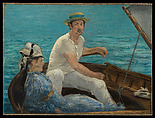
This artwork is meant to be viewed from right to left. Scroll left to view more.
Fig. 1. Mary Cassatt, "The Boating Party," 1893/1894, oil on canvas, 35 7/16 x 46 3/16 in. (90 x 117.3 cm) (National Gallery of Art, Washington)
Fig. 2. Stop, “La Femme Edredon, par M. Manet, chef de l’entreprise des bateaux coupés” (The Eiderdown-Woman, by Mr. Manet, leader of the business of cut boats), "Le Journal amusant," June 14, 1879, no. 204 (Bibliothèque nationale, Paris) (Repro’d. in Darragon 1991, p. 404, no.339.)
Fig. 3. Edouard Manet, "Boats at Sea, Sunset," ca. 1868, oil on canvas, 43 x 94 cm (Musée d’art moderne André Malraux, Le Havre)
Fig. 4. Edouard Manet, "Argenteuil," 1874, oil on canvas, 149 x 115 cm (Musée des Beaux-Arts, Tournai)
Fig. 5. Edouard Manet, "The Swallows," 1873, oil on canvas, 65 x 81 cm (Foundation E. G. Bührle Collection, Zürich)
Fig. 6. Edouard Manet, "On the Beach," 1873, oil on canvas, 95.9 x 73 cm (Musée d’Orsay, Paris)
Artwork Details
Use your arrow keys to navigate the tabs below, and your tab key to choose an item
Title: Boating
Artist: Edouard Manet (French, Paris 1832–1883 Paris)
Medium: Oil on canvas
Dimensions: 38 1/4 x 51 1/4 in. (97.2 x 130.2 cm)
Classification: Paintings
Credit Line: H. O. Havemeyer Collection, Bequest of Mrs. H. O. Havemeyer, 1929
Accession Number: 29.100.115
Learn more about this artwork
Timeline of art history, couples in art, impressionism: art and modernity, édouard manet (1832-1883), france, 1800-1900 a.d., museum publications.

The Romantic Vision of Caspar David Friedrich: Paintings and Drawings from the U.S.S.R.

The Metropolitan Museum of Art: Masterpiece Paintings

The Metropolitan Museum of Art. Vol. 8, Modern Europe

The Metropolitan Museum of Art Guide

Splendid Legacy: The Havemeyer Collection

Masterpieces of The Metropolitan Museum of Art

Masterpieces of Painting in The Metropolitan Museum of Art
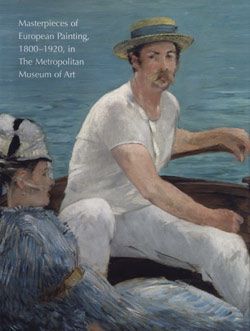
Masterpieces of European Painting, 1800–1920, in The Metropolitan Museum of Art

Manet/Degas

Manet, 1832–1883

Looking to Connect with European Paintings: Visual Approaches for Teaching in the Galleries
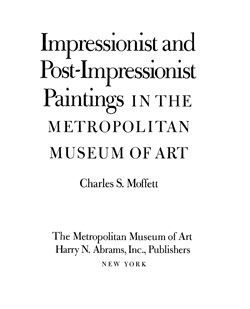
Impressionist and Post-Impressionist Paintings in The Metropolitan Museum of Art

Impressionism: A Centenary Exhibition

Guide to The Metropolitan Museum of Art

French Paintings: A Catalogue of the Collection of The Metropolitan Museum of Art. Vol. 3, Nineteenth and Twentieth Centuries
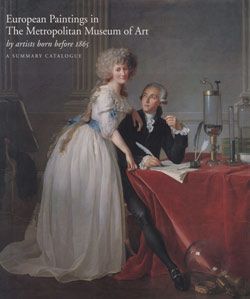
European Paintings in The Metropolitan Museum of Art by Artists Born before 1865: A Summary Catalogue

Art = Discovering Infinite Connections in Art History
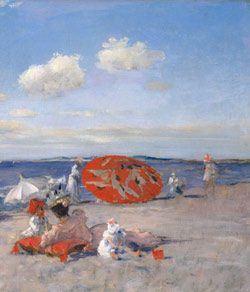
American Impressionism and Realism: The Painting of Modern Life, 1885–1915

"The Impressionist Brush"

"Impressionists in the Metropolitan"
Related artworks.
- All Related Artworks
- In the same gallery
- By Edouard Manet
- European Paintings
- From Europe
- From France
- From A.D. 1800–1900
Cat and Flowers
The Smoker (Le Fumeur)
Boy with Soap Bubbles
The Water Drinker
Resources for research.
The Met's Libraries and Research Centers provide unparalleled resources for research and welcome an international community of students and scholars.
The Met Collection API is where all makers, creators, researchers, and dreamers can connect to the most up-to-date data and public domain images for The Met collection. Open Access data and public domain images are available for unrestricted commercial and noncommercial use without permission or fee.
We continue to research and examine historical and cultural context for objects in The Met collection. If you have comments or questions about this object record, please complete and submit this form . The Museum looks forward to receiving your comments.
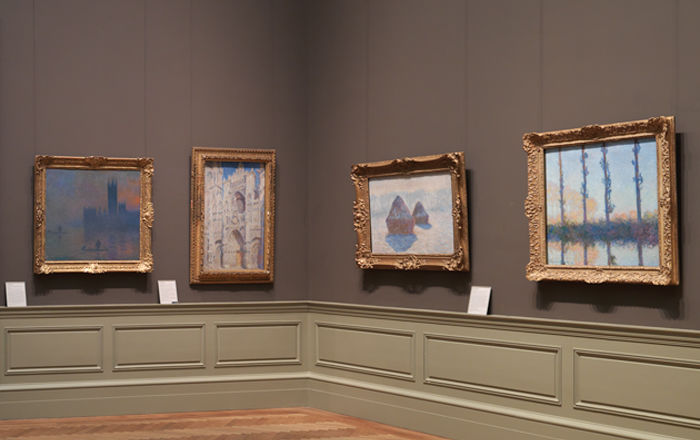
European Paintings at The Met

Step-by-Step Guide: How to Paint a Sailboat with Acrylics
Alex Morgan
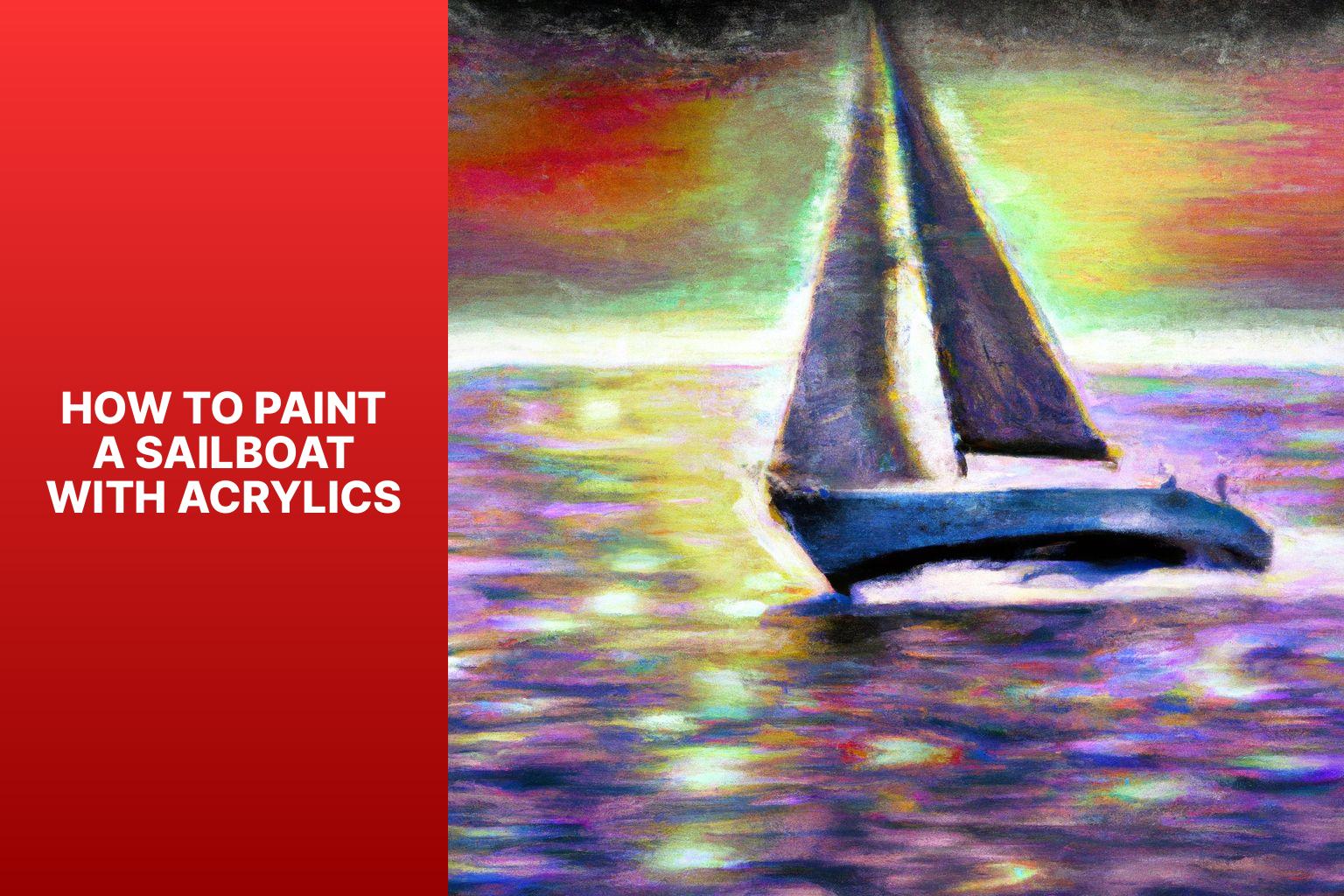
Painting a sailboat with acrylics can be a rewarding and enjoyable artistic endeavor. Whether you are a beginner or an experienced artist, this article will provide you with a comprehensive guide to creating a stunning sailboat painting using acrylic paints.
To begin with, you will need specific materials and tools to ensure a successful painting process. These include acrylic paints in various colors, a set of brushes suitable for acrylic painting, a palette for mixing colors, a canvas or painting surface, a water container for cleaning brushes, a palette knife for texture, and a reference image or sketch of a sailboat.
Before you start painting, it is essential to prepare the surface properly. This involves cleaning the surface to remove any dust or debris, and then applying a layer of primer or gesso to create a smooth and even base for your paint to adhere to.
To achieve the desired result, it is important to understand and practice basic techniques for painting with acrylics. This includes learning how to mix colors to create different shades and tones, how to layer and blend colors to add depth and dimension, and how to create texture and detail in your sailboat painting.
Once you are familiar with the techniques, you can follow a step-by-step guide to painting a sailboat. This includes sketching the sailboat outline, blocking in the background colors, adding base colors to the sailboat, adding details and highlights, and refining the painting to ensure a polished and professional look.
To complete your sailboat painting, don’t forget the finishing touches and sealing the artwork to protect it and enhance its longevity. We will share some tips and tricks to help you master the art of painting a sailboat with acrylics, allowing you to express your creativity and create beautiful marine-inspired artworks. So gather your materials and get ready to set sail on your artistic journey!
Key takeaway:
- Using acrylic paints and appropriate tools is essential for painting a sailboat. Acrylic paints are versatile and easy to work with.
- Properly preparing the surface by cleaning and applying primer or gesso ensures a smooth painting surface.
- Understanding basic techniques such as color mixing, layering, blending, and creating texture and detail is important for painting a realistic sailboat.
- Following a step-by-step guide helps in achieving a well-executed sailboat painting.
- Finishing touches and sealing the painting enhance its longevity and protect it from damage.
- Tips and tricks such as using reference images or sketches and refining the painting contribute to a successful acrylic sailboat painting.
Materials and Tools Needed for Painting a Sailboat
Are you ready to set sail on a creative painting journey? This section has all the juicy details about the materials and tools needed to paint a stunning sailboat with acrylics. We’ll dive into the vibrant world of acrylic paints , the magic touch of different brushes , the perfect palette for mixing colors, the ideal canvas or painting surface, the essential water container and palette knife , and the importance of having a reference image or sketch. Get your creative gears ready, because we’re about to embark on an artistic adventure !
Acrylic Paints
When painting a sailboat with acrylic paints , it is crucial to choose the right type of acrylic paint . Consider the following factors when selecting acrylic paints :
– Quality : Opt for high-quality acrylic paints for vibrant and long-lasting colors.
– Color range : Look for brands that offer a wide range of colors, including various shades of blue for painting the sky, water, and sails of the sailboat.
– Opacity : Consider the opacity of the acrylic paints . Some colors are more opaque, allowing for solid coverage, while others are more transparent, allowing for layering and glazing techniques.
– Drying time : Check the drying time of the acrylic paints . Faster drying paints are great for quickly building layers, while slower drying paints allow for more blending and wet-on-wet techniques.
– Brand reputation : Research and choose acrylic paints from reputable brands known for their quality and consistency.
Pro-tip : Before starting your painting, it’s recommended to do a small color swatch test to see how the colors appear on your chosen canvas or painting surface. This will help you make any necessary adjustments before committing to the final artwork.
When painting a sailboat with acrylics, the right brushes are crucial for achieving desired results. Here is a list of brushes to consider:
1. Round brushes: Perfect for creating fine details like rigging and small waves. They come in various sizes, from small for intricate work to larger for broader strokes.
2. Flat brushes: Ideal for creating straight lines and sharp edges. Great for painting sails, the horizon, or other flat surfaces on the sailboat.
3. Fan brushes: Excellent for creating texture like foliage or water splashes. Can also blend colors and create soft, feathery strokes.
4. Filbert brushes: Versatile brushes for both fine details and broader strokes. Particularly useful for painting the hull and larger areas.
5. Detail brushes: Perfect for adding intricate details and highlights. Allows for precise control in adding fine lines, textures, and highlights.
Fact: Using the right brushes not only makes painting a sailboat easier but also enhances the overall quality of your artwork. Experimenting with different brush shapes and sizes can help achieve different effects and add depth to the painting.
When painting a sailboat with acrylics , a palette is essential for effectively mixing and organizing colors. A palette serves as a flat surface where you can arrange and blend paints.
Canvas or Painting Surface
Choosing the right canvas or painting surface is crucial for a successful sailboat painting with acrylics. The size and material of the canvas are important factors that affect the outcome of the painting.
A larger canvas allows for more details and a grander composition, while a smaller canvas is more manageable and quicker to complete. The most popular canvas materials are cotton , linen , and polyester .
Cotton canvas is affordable and suitable for beginners. Linen canvas , though more expensive, offers a smoother surface and better longevity. Polyester canvas is a synthetic option that is resistant to moisture. Regardless of the material you choose, it is important to prime the canvas with gesso or primer before painting.
This creates a smooth and stable surface for the acrylic paints, resulting in better color vibrancy and a longer-lasting artwork. When selecting a canvas or painting surface, consider your artistic vision and preferences to create a stunning sailboat painting with acrylics.
Water Container and Palette Knife
The sub-topic “ Water Container and Palette Knife ” in the article “ How To Paint A Sailboat With Acrylics ” can be represented in a table format:
| A container used for cleaning brushes and diluting acrylic paints. It can be a small cup or jar with a wide opening. | |
| A flat, blunt tool with a flexible blade used for mixing colors, applying paint, creating texture, scraping off mistakes, and adding fine details. |
Using a water container is essential in acrylic painting to keep your brushes clean and prevent paint from drying. The container should be filled with clean water and changed when dirty to ensure a constant supply of clean water for rinsing and thinning paint.
The palette knife is a versatile tool for mixing colors directly on the palette. Its flat blade is perfect for scraping and lifting paint, allowing for experimentation with color combinations and creation of various textures in artwork. The palette knife can be used to apply paint directly to the canvas for precise and controlled brushwork.
By having a water container and palette knife in your painting toolkit, you’ll be equipped to efficiently and creatively work with acrylic paints, bringing your sailboat painting to life.
Reference Image or Sketch
When painting a sailboat with acrylics, having a reference image or sketch is crucial for accuracy and capturing the essence of the subject. The reference image serves as a visual guide, helping artists understand the structure, proportions, and details of the sailboat.
To create a reference image or sketch, start by selecting a clear and high-resolution photograph of the sailboat. It should showcase the desired angle and composition for the painting. Then, use a pencil or grid method to transfer the main outlines and important features onto your canvas or painting surface.
The reference image or sketch acts as a roadmap throughout the painting process. It helps artists determine the placement of the sailboat, the position of the sails, the shape of the hull, and other details. By referring to the image or sketch, artists can ensure accuracy and achieve a realistic representation of the sailboat.
Remember to use the reference image or sketch as a guideline rather than strictly copying it. Allow yourself to add your own artistic interpretation and style to make the painting unique. Experiment with colors, textures, and brushwork to bring the sailboat to life on your canvas.
With a well-prepared reference image or sketch, artists can confidently paint a sailboat with acrylics, capturing its beauty and spirit in their artwork.
Preparing the Surface for Painting
Preparing the surface is a crucial step in painting a sailboat with acrylics . In this section, we’ll discover the necessary techniques to ensure a smooth and long-lasting finish. First, we’ll explore the importance of cleaning the surface thoroughly. Then, we’ll dive into the significance of applying primer or gesso before starting the actual painting process. These essential steps will set the foundation for a successful sailboat painting adventure. So let’s get our brushes ready and make that canvas shine!
Cleaning the Surface
When preparing to paint a sailboat with acrylics, it is essential to follow these important steps for cleaning the surface:
1. Begin by using a soft brush or cloth to remove any dust or debris from the surface. This step is crucial for ensuring proper adhesion of the paint.
2. In case there are stains or dirt that cannot be removed using a brush, gently clean the area with mild soap and water. It is important to avoid harsh chemicals as they may cause damage.
3. Prior to painting, it is necessary to eliminate any peeling or flaking paint. This can be done by carefully smoothing the surface using sandpaper or a scraper.
4. After the cleaning and preparation process, it is recommended to apply a layer of primer or gesso. This will create a smooth surface, enhancing color saturation and durability.
Remember to take your time and handle the surface gently during the cleaning process to prevent any damage. Properly cleaning and preparing the surface guarantees a beautiful painting that will last for a long time.
Applying Primer or Gesso
Applying primer or gesso is necessary for preparing the surface before painting a sailboat with acrylics . It creates a smooth base for the paint, improving the quality and durability of the artwork.
To apply primer or gesso:
- Clean the surface: Remove dust, dirt, and grease using a soft cloth or brush.
- Choose the right primer or gesso: Use acrylic gesso , which dries quickly and works well with acrylic paints.
- Prepare the primer or gesso: Stir it thoroughly and thin with water if needed, following the manufacturer’s instructions.
- Apply the primer or gesso: Use a brush or palette knife to apply an even layer, covering the entire area to be painted.
- Allow drying time: Let the primer or gesso dry completely, which usually takes 1-2 hours, but may vary based on the product and environment.
Applying primer or gesso creates a strong foundation for your sailboat painting, ensuring vibrant colors and good adherence to the surface. It also prevents unwanted paint absorption into the canvas or other surfaces. Follow the manufacturer’s instructions for best results.
Understanding Basic Techniques for Painting a Sailboat
Discover the vibrant world of sailboat painting as we delve into the fundamental techniques that bring these majestic vessels to life. From mixing colors to layering and blending, and even creating texture and detail, we’ll explore the artistry and skill required to capture the essence of a sailboat on canvas. Get ready to embark on a creative journey as we unlock the secrets of painting a sailboat with acrylics !
Mixing Colors
When mixing colors in acrylic painting, there are techniques to achieve the desired result.
– Start with the primary colors : red, blue, and yellow. These are the foundation for all other colors.
– Use a color wheel to understand color relationships. Opposite colors on the wheel, such as blue and orange, create contrast when mixed.
– Experiment with different color ratios to create shades and tints. Adding more blue to yellow creates a green shade , while adding more yellow to blue creates a green tint .
– Gradually add small amounts of one color to another, mixing and blending until the desired hue is achieved.
– Consider the effect of adding white or black to a color. Adding white creates a lighter shade , while adding black creates a darker shade .
– Take note of the drying time of acrylic paints, as the color may slightly shift once dry. Let the mixed colors dry before making adjustments.
– Clean brushes thoroughly between color mixing to avoid contamination and achieve accurate colors.
By understanding these mixing techniques, you can confidently create a wide range of colors for your sailboat painting. Experiment and explore different combinations to achieve unique and vibrant results.
Layering and Blending
Layering and blending are pivotal techniques in the realm of acrylic painting. Employ the following strategies to attain the desired effect:
– Emphasize layering: Begin by applying thin coats of paint and gradually intensify the color and texture in order to exercise better control over the varying shades and values.
– Master the art of wet-on-wet blending: Meld hues by applying wet paint atop another still wet layer, resulting in seamless transitions and smooth gradients.
– Harness the power of dry brushing: Utilize a minimal amount of paint with a dry brush to fashion texture and highlights, which is ideal for incorporating intricate details.
– Embrace glazing: Introduce translucent layers of paint onto dry layers to yield depth and radiance, thereby permitting subtle variations in color and an atmosphere-like aura.
– Achieve blending with a palette knife: Directly mix and blend colors on the painting surface using a palette knife, imbuing the artwork with texture and dimension.
Experiment with these techniques to ascertain the most effective approach. The combination of layering and blending can augment the depth, dimension, and opulence of your acrylic paintings, thereby enabling you to create captivating sailboat masterpieces.
Creating Texture and Detail
Creating texture and detail is essential when painting a sailboat with acrylics . These techniques enhance the depth and visual interest of the artwork. To achieve texture, it is recommended to utilize methods such as dry brushing , sponging , or palette knife strokes.
Implementing these techniques effectively can add texture not only to the sails , water , but also to the boat as a whole.
One approach to create texture on the sails is by using the dry brush technique. This involves applying a small amount of paint to a dry brush and gently brushing it onto the canvas. By doing so, a rough and textured appearance is achieved, giving the impression of fabric on the sails. To replicate waves and ripples on the water, consider using a palette knife to apply thick, undiluted paint with a scraping motion.
Adding intricate details is crucial in bringing the sailboat to life. Using fine brushes and thin paint, you can incorporate intricate elements such as rigging , ropes , and various features on the boat. Paying close attention to these details will greatly enhance the realism and overall quality of the painting.
Don’t be afraid to experiment with different techniques and brushes in order to achieve the desired textures and details. Remember, practice and patience are key when mastering the art of creating texture and detail in sailboat paintings.
Fun Fact: Incorporating texture and detail in a painting can give the artwork a three-dimensional appearance, captivating viewers.
Step-by-Step Guide to Painting a Sailboat
Master the art of painting a sailboat with acrylics with this step-by-step guide.
We’ll take you through the process, from sketching the sailboat to refining the final touches.
Discover how to block in the background, add base colors, and bring your sailboat to life with details and highlights.
With these expert tips and techniques, you’ll be able to create a stunning sailboat painting that showcases your artistic skills.
Get ready to embark on a creative journey and immerse yourself in the world of sailboat artistry.
Sketching the Sailboat
To begin sketching the sailboat before painting with acrylics, follow these steps:
1. Take a blank canvas or painting surface.
2. Take a look at the reference image or sketch of the sailboat.
3. Recognize the basic shapes and proportions of the sailboat, including the hull , sails , and mast .
4. Use a pencil or charcoal to create a light outline of the sailboat on the canvas. Begin with simple shapes and lines.
5. Pay close attention to the positioning and size of various elements, such as the sails and the angle of the mast.
6. Add more intricate details to the sketch, such as windows, ropes, or flags. It is important to ensure accurate proportions and perspectives.
7. Erase any unnecessary lines or mistakes while refining the sketch. Focus on capturing the overall shape and composition.
8. Once you are satisfied with the sketch, go over the lines with a fine-tipped pen or marker to define them. Alternatively, you can use a dark pencil.
9. Review the sketch to make sure it accurately represents the sailboat and the desired composition.
10. The sketch is now ready to serve as a guide for painting the sailboat with acrylics.
By following these steps, you can create a detailed and accurate sketch of a sailboat before starting the painting process.
Blocking in the Background
Blocking in the background is an important step in painting a sailboat with acrylics. It establishes the composition and sets the tone for the rest of the painting. Here is a step-by-step guide on how to block in the background :
1. Choose the colors for the background based on the atmosphere and mood you desire. Soft blues and greens create a calm and serene scene, while bold and contrasting colors produce a dramatic and vibrant effect.
2. Apply the background colors onto the canvas with a large brush, starting from the top and working your way down. Use broad strokes to cover the entire background area.
3. Block in the basic shapes and forms of any objects or elements that will be part of the background, such as the sky, clouds, trees, or distant land .
4. Focus on capturing the general shapes and colors rather than intricate details. Use loose and expressive brushstrokes at this stage.
5. Blend the colors together where they meet to create a smooth transition. Use a clean, damp brush to softly blend the edges.
6. Step back and assess the overall look and feel of the background. Make necessary adjustments to the colors or shapes to ensure it complements the rest of the painting.
By following these steps, you can effectively block in the background of your sailboat painting and set the stage for the rest of your artwork.
Blocking in the background has been used by artists for centuries to establish the foundation of a painting. It creates depth, atmosphere, and a harmonious composition. Whether it’s a landscape, still life, or sailboat painting, blocking in the background is an essential part of the painting process, allowing artists to develop their vision and bring their artwork to life.
Adding Base Colors to the Sailboat
To effectively add base colors to the sailboat when painting with acrylics, adhere to the following instructions:
1. Begin by preparing your palette with the necessary base colors for the sailboat. This includes utilizing blue for the water, white for the sails, and brown for the wooden parts.
2. Use your brush to apply the first base color to the appropriate areas of the sailboat. For larger areas, employ broad strokes , while smaller details require finer strokes .
3. Layer each base color onto its respective area of the sailboat, ensuring smooth and even coverage. Add additional coats as needed.
4. When necessary, seamlessly blend the base colors together. This can be achieved by gently mixing the colors with either a clean brush or a palette knife, resulting in a gradual gradient .
5. Throughout the painting process, refer to your chosen image or sketch to ensure accurate color placement and shading.
6. Before proceeding to add details and highlights to the sailboat, allow the base colors ample time to dry completely .
By following these steps attentively, you will lay a solid foundation for your sailboat painting by effectively and accurately incorporating the base colors.
Adding Details and Highlights
When adding details and highlights to a sailboat painting with acrylics , consider techniques that enhance the realism and quality of the artwork.
1. Use a smaller brush size .
2. Mix the appropriate colors .
3. Apply thin layers of paint.
4. Focus on light and shadows.
5. Use a dry brush technique for highlights .
6. Add finer details with a fine liner brush .
7. Step back and assess the painting regularly.
Following these guidelines, artists can create depth and dimension in their sailboat paintings while capturing the essence of light and highlighting important elements of the subject.
Refining the Painting
To refine a sailboat painting with acrylics, the first step is to assess the sailboat’s composition and proportions. It is important to adjust as necessary in order to accurately represent the sailboat. Once the basic structure of the sailboat is in place, it is time to refine the details. This can be done by adding fine lines, curves, and shading for depth.
To make the painting more visually appealing, highlights should be added to catch the light, such as on the sail edges and hull. In order to achieve a realistic effect, it is important to blend colors seamlessly. After the sailboat itself is refined, attention should be turned to the background. Evaluate and enhance the background colors to ensure they complement the sailboat. If necessary, improve the water texture and depth to add more dimension to the painting.
To truly bring the painting to life, consider adding additional details like seagulls or waves. After all the refinements have been made, step back and evaluate the final painting. Make any touch-ups or adjustments as necessary to perfect the artwork. The process of refining the painting is crucial for capturing the beauty and intricacies of a sailboat with acrylics. These final touches will truly make the artwork special and bring it to life.
Finishing Touches and Sealing the Painting
To complete the sailboat acrylic painting, follow these steps for the finishing touches and sealing :
1. Remove any masking tape or painter’s tape used to create clean lines.
2. Inspect the painting for touch-ups or additional details. Use small brushes and acrylic paint to carefully add necessary final touches.
3. Allow the painting to dry completely before proceeding to sealing.
4. Use a varnish or sealant specifically made for acrylic paintings. Apply a thin, even coat using a soft brush. Follow the manufacturer’s instructions .
5. Let the varnish dry completely, which typically takes several hours.
6. Inspect the painting for any missed areas during the sealing. Touch up these spots with more varnish .
7. Consider applying a second coat of varnish for extra protection and a glossier or matte finish. Follow the manufacturer’s instructions and let each coat dry completely.
8. Once the painting is fully sealed and dry, you can frame or display it as desired.
By following these steps, you can add the finishing touches and seal your acrylic sailboat painting to protect and enhance its appearance.
Tips and Tricks for Painting a Sailboat with Acrylics
Here are some practical tips and tricks for painting a sailboat with acrylics:
1. Prepare your workspace by covering it with newspaper or a drop cloth to avoid paint splatters or spills.
2. Start by sketching the sailboat outline on your canvas using a pencil as a guideline.
3. Mix your acrylic paints on a palette to achieve the desired colors for the hull, sails, and details.
4. Use a larger brush to paint the background and base colors of the sailboat. Apply thin layers of paint and let each layer dry before adding another.
5. Once the base colors are dry, use a smaller brush to add details like windows , ropes , and flags . Pay attention to the intricate features of the sailboat.
6. Create depth and dimension by adding shadows and highlights . Use lighter shades for areas that catch the light and darker shades for areas in shadow.
7. To add texture to the water surrounding the sailboat, use a palette knife or dry brush technique for a more realistic and dynamic look.
8. Allow the painting to dry completely before adding final touches or varnish to protect it.
By following these tips and tricks, you can create a beautiful sailboat painting with acrylics.
Some Facts About How To Paint A Sailboat With Acrylics:
- ✅ Acrylic paint is commonly used for painting sailboats due to its versatility and quick drying time.
- ✅ Sailboat paintings created with acrylics can capture the vibrant colors of the water and sky.
- ✅ Using different brush techniques and layering, artists can create texture and depth in their sailboat paintings.
- ✅ Acrylic paints are available in a wide range of colors, allowing artists to accurately depict the details of a sailboat.
- ✅ To protect the finished sailboat painting, artists often apply a varnish or sealant to ensure its longevity.
Frequently Asked Questions
Faqs for “how to paint a sailboat with acrylics”, q: how can i cancel my contracts or subscriptions with youtube.
A: To cancel your contracts or subscriptions with YouTube, you can visit the “Verträge hier kündigen” section on YouTube. This section provides information and instructions on how to terminate your agreements with YouTube.
Q: Can I participate in testing new features on YouTube?
A: Yes, you can! YouTube offers an opportunity for users to test new features before they are widely released. Simply go to the “Neue Funktionen testen” section and follow the instructions to opt-in for testing new features on YouTube.
Q: Where can I find the guidelines and safety measures for using YouTube?
A: You can find the guidelines and safety measures for using YouTube in the “Richtlinien & Sicherheit” section. This section provides detailed information on YouTube’s community guidelines, rules against harassment and hate speech, and other safety measures to ensure a positive and secure experience on the platform.
Q: What information does the NetzDG Transparenzbericht on YouTube provide?
A: The NetzDG Transparenzbericht on YouTube offers information about the company’s compliance with the NetzDG law in Germany. It provides transparency reports related to efforts in combating illegal content and hate speech on the platform.
Q: How does YouTube work? Can you provide an overview?
A: YouTube is a video-sharing platform where users can upload, view, and interact with videos. In the “Wie funktioniert YouTube?” section, you can find a comprehensive overview of how YouTube works, including instructions on creating an account, uploading videos, and engaging with other users.
Q: Who owns the copyright for content on YouTube?
A: Google LLC owns the copyright for content on YouTube until 2023, as indicated by the “© 2023 Google LLC” statement. Users should be aware of the terms and conditions regarding copyright ownership when using YouTube.
About the author
Leave a Reply Cancel reply
Your email address will not be published. Required fields are marked *
Save my name, email, and website in this browser for the next time I comment.
Latest posts

The history of sailing – from ancient times to modern adventures
History of Sailing Sailing is a time-honored tradition that has evolved over millennia, from its humble beginnings as a means of transportation to a beloved modern-day recreational activity. The history of sailing is a fascinating journey that spans cultures and centuries, rich in innovation and adventure. In this article, we’ll explore the remarkable evolution of…

Sailing Solo: Adventures and Challenges of Single-Handed Sailing
Solo Sailing Sailing has always been a pursuit of freedom, adventure, and self-discovery. While sailing with a crew is a fantastic experience, there’s a unique allure to sailing solo – just you, the wind, and the open sea. Single-handed sailing, as it’s often called, is a journey of self-reliance, resilience, and the ultimate test of…

Sustainable Sailing: Eco-Friendly Practices on the boat
Eco Friendly Sailing Sailing is an exhilarating and timeless way to explore the beauty of the open water, but it’s important to remember that our oceans and environment need our protection. Sustainable sailing, which involves eco-friendly practices and mindful decision-making, allows sailors to enjoy their adventures while minimizing their impact on the environment. In this…

How To Paint A Sailboat: A Complete Guide

Last Updated by
Daniel Wade
June 15, 2022
Whether you’re new to owning a sailboat or not, you have likely put some thought into painting your boat yourself. It is important to keep your boat well painted as it can save you a lot of money in the long run. It can also save you a lot of money if you choose to paint your boat yourself.
Whether or not this is the first time you have painted your boat, you will still find this article useful. It has lots of tips and tricks for making sure you get the job done and get it done well. Hiring a professional may be easier, but there is a sense of pride and accomplishment in doing it yourself. If you use this article as a reference, you can’t go wrong.
Table of contents
Why is it important to paint your sailboat?
Painting your boat is not just an excuse to put some creative flair into your boat, it is an important process in keeping the boat safe. Safe from salt, safe from barnacles, and safe from damage. The paint acts as a vital protective layer, without it your boat will be vulnerable to all kinds of damage. If you have a wooden hull, this protective layer will keep the wood from rotting. It can also plug any minuscule holes that might allow sea life and salt to make its way into the body of the boat.
There is also, of course, the added benefit of having a boat that looks good . A boat is a point of pride and should be treated as such. Having a glossy looking boat is something to be proud of. Most boats are not painted far above the waterline, so it is even an opportunity to make your boat stand out. Some people also believe that painting a boat brings good luck. Unless of course, you paint it green, green is thought to bring bad luck. Whether or not you believe that is up to you.
What are the benefits of painting your boat yourself?
When it comes to painting your boat there are only two options. Hire a professional boat painting contractor, or bite the bullet and do it yourself. They both have their pros and cons, of course, but there is so much more to be gained by doing it yourself. First of all, painting your boat yourself is just as fun as it is difficult. Learning to paint is a valuable life skill that you won’t regret learning as early on in your sailing career as possible. If you can learn to paint your boat now, you will save yourself a small fortune in the long run.
Hiring a contractor is expensive, to say the least, it may be faster and easier overall, but the extra cost can make it simply not feasible. Or simply unappealing. If this is the first time you are painting your sailboat you will need to make a one-off purchase of all the equipment needed for prepping, painting, and finishing the boat. After these one-off purchases are out of the way, you will only need to buy paint and new rollers the next time. Even if you need to buy all the equipment brand new, it can be cheaper than hiring someone else to do the job for you.
How often do you need to paint your sailboat?
The general rule of thumb for painting your boat is that it will need bottom paint about once a year. This is when you will need to take the boat completely out of the water and give it a fresh new coat. If your boat spends all of its time in the water, it certainly needs painting at least once a year. The saltwater is so corrosive that you shouldn’t let your boat go without a fresh coat of bottom paint for more than 2 years. Even if your boat only spends half its time in the water, and the other half on land, you will find that its best to keep its coat topped up.
The top paint, or the above waterline paint, doesn’t need painting anywhere near as often. It isn’t in direct contact with the seawater so it simply isn’t going to get eroded down as much. The salty sea spray can still be damaging over time so this paint should be re-done every 3 years. It can be more or less frequent depending on use and personal preference. Some people like to do above waterline paint yearly, with the rest of their boat, but it isn’t necessary.
What are the best paints to use for your sailboat?
There are plenty of great brands of paint out there, in various colors and shades, so you won’t struggle for choice. There are some things you might want to look for in your paint . For example, you may have noticed that a lot of boats tend to have red hulls. This isn’t just a fashion statement, and while red is supposed to bring luck this isn’t the main reason either. The reason is that this red/orange paint is perfect for added protection along the bottom of your boat.
This red/orange paint is interestingly chosen because it is, of course, traditional; but mostly because of its copper. The copper is actually what gives the paint its red/orange color.
Copper is perfect for the bottom of your boat for several reasons. First, copper acts as a biocide. It stops worms from making their way into the hull if your boat is wooden. If it is metal or fiberglass, it still has the benefit of stopping barnacles and other sea life from attaching themselves deep into the hull of the boat. Copper is also strong enough to hold up to scraping.
Scraping is when you scrape barnacles and other sea life off the hull of your boat. Scraping is an important part of keeping your boat in good condition. It is important to check with the marina or port authority whether or not you are allowed to scrape. If you scrape without permission you may find yourself on the receiving end of a hefty fine. The reason is that they don’t want you introducing invasive species on to the marina floor. This is mostly a problem when you are coming from somewhere vastly foreign, not sailing from New York to Chicago for example.
How many coats of paint does a sailboat need?
When painting your boat it’s a good idea to think about how many coats of paint you are going to need. There is no exact number that is needed, it is mostly to do with how well protected your boat needs to be and how much time you have on your hands. Every coat takes time and attention to detail.
If you choose to do four coats of paint it is going to be time-consuming but very well protected. That being said, the minimum number of coats is two. One is not enough. If your boat only spends part of the time in the water, two to three coats are plenty.
If you are someone who lives on their boat full-time, or at least most of the time, you may want to do more coats. Three, maybe even four, might be ideal here. The reason is that first, your boat is going to experience way more wear and tear than one that is just an ocean part-timer. And second, taking out your boat (which is also your home) is a giant hassle. It is a tedious process, so doing it as infrequently as possible is probably in your best interest. More coats last longer. When you are sailing from place to place, finding somewhere to take your boat out of the water and perform this maintenance is inconvenient. You want to be doing it as little as possible.
What safety precautions do I need to take when painting my sailboat?
All paint can be toxic when inhaled. Even if it is “non-toxic” paint it is going to be harmful to your lungs. They aren’t meant to inhale anything but air, even non-toxic paint is going to be bad for them. This is why it is important to wear a face mask.
Your mask should be specifically for painting, not surgical masks or other cheap medial masks. They are not going to be strong enough, with a fine enough air filter. Whether you feel the need to wear eyewear is up to you during the painting process.
Before the painting begins, when you are scraping and sanding, it is a good idea to wear some goggles to keep debris and splinters out of your eyes. It is also a good idea to wear gloves. You don’t want to rough your hands up too much, they need protection from not only the paint but splinters and sharp pieces of metal.
Painting a boat can be dangerous work. Without taking the proper safety precautions you are putting yourself at unnecessary risk. This safety equipment costs just a few bucks and is equally important as any of the other tools needed to paint your boat.
What tools do I need to paint a boat?
There is more to painting your boat than just using paint and a brush . You will also need tough sandpaper , potentially an angle grinder or welder , paint, primer , brushes, paint rollers , paint thinner , and solvent. You will need to make sure you have all of these things before you start painting. You can pick any of these items up at a boating goods store.
It is a good idea to bring some buckets with you for filling with water, both for rinsing off your boat and your brushes. All of your safety equipment needs to be brought too.
If this is your first time painting your boat yourself, you may find you need to buy all of these things at once. That can be a lot to stomach when its all in one go, luckily, most of these tools and equipment can be reused. Besides, it is still going to be far cheaper than hiring someone to do it for you. All of this equipment is an investment in your boat.
How to paint a sailboat
Whether this is the first time you have painted your boat or not, you may find some of the tips in this next section useful. Painting your sailboat may be tricky at first, but over time you will get the hang of it. The problem with painting your boat is that it can be a very expensive mistake if you get it wrong.
It is important to read this guide carefully, take your time, and make sure you do the job properly. It may be slow going at first, speed will come over time. Once you have gathered all of your safety equipment and tools you are ready to get started.
The workspace
First of all, you need to ensure you have the right workspace. You cant paint your boat in the water so you are going to need to find somewhere to do your work. This is easy enough if you don’t live on your boat full time, take the boat to your house and do your painting on the driveway. If this isn’t an option because you don’t have space or live on your boat full time, you are going to need to rent somewhere. There are typically places affiliated with the marina that you can use. In some cases, these even come with a majority of the equipment you will need. This, of course, drums up the price a bit, but that’s unavoidable.
Your workspace needs to be well ventilated, or you risk making yourself very sick. Both from paint fumes, rubbing alcohol fumes, and fine matter from when you sand the hull down. This means painting your boat in your garage, if it even fits, is not always the best idea. If you do decide to paint outside, it is important to consider the chance of rain. Of course, your boat is pretty waterproof, but once you begin sanding rain might damage the wood if left to sit there.
Before you do anything else, it is important to look your boat over fully from top to bottom. You are looking for any bumps, scrapes, cracks and general damage. This damage is not going to be noticeable while the boat is in the water, so just before you paint it is one of the only times you get to have a close look. Once you have made note of all this damage, it is time to get to work repairing it. Depending on just how severe this damage is, you may want to get help with this next stage.
All of this damage needs to be repaired before anything else can take place. Painting over these damaged areas is just going to hide the problem temporarily, the next time it comes to painting you will find they are far worse. If you don’t deal with this now, they are going to snowball into complicated and expensive repairs.
After your repairs are done it is time to start sanding. This is very time consuming as you need to do it three times. Per coat. First, take the 600 grit sandpaper and make your way around the boat. It is best to use electrical tape to mark out a section at a time so you don’t keep losing your place. After you have finished with the 600 grit sandpaper, it is time to move on to 800, then 1200. This process is important so you will be painting on as smooth a surface as possible. It is then a good idea to wipe the surfaces of the boat down with a damp cloth to remove any of the dust and flakes of metal/wood. Otherwise, you end up painting over them.
You could wash the boat down with a hose but you want to avoid getting the boat unnecessarily wet now that the hull has lost its protective layer. If you are sanding down a boat with a copper paint bottom, you may find the sanding process difficult. Just do your best, it doesn’t need to be 100% perfect. It is important to get as much of the old paint off as possible. Your new paint won’t adhere to the old paint as well as it would to the boat hull itself.
Putting on a layer of primer is not 100% necessary but it is recommended. The idea is that you want your topcoat to adhere to the boat as well as possible, a layer of primer can help you do that. The primer needs to be painted on evenly all over the boat. If you only feel like doing below the waterline, that is fine too. It will save you a lot of time. Putting on the layer of primer is not the most time-consuming part, it is mostly the sanding down that you will have to do. You will need to sand down using the 600 grit paper, then the 800, then 1200. Just like last time. Your layer of primer needs to be as smooth as possible for the maximum adhesion.
Now comes the paint. It is recommended to do at least two layers of paint. One undercoat and one top. Some people choose to go as far as two layers of primer, two layers of undercoat, and three layers of topcoat. This is going to be very time consuming, remember you will need to sand down three times between each layer of paint. You can paint using a brush if you like but is far easier to use a roller. It is also far easier if you employ someone to help you with this stage. It could be your spouse, child, friend, or anyone. It doesn’t need to be a paid professional. It can take a long time to go through this process. Especially if you are effectively doing 8 layers of paint (including primer).
The fastest way to paint, especially if you are on your own, is to use a sprayer. They are easy to use, with a little practice. If you haven’t used one before you may find that you struggle to get an even coat. You should always paint in vertical stripes, not horizontal. Additionally, it is a good idea to have someone following after you with a small brush doing small touch-up jobs. Any unevenness will need to be sanded down and repainted. The whole painting process can take a week if you aren’t efficient.
Take pictures
It is a good idea to take pictures throughout the whole process. This is for future reference. For example, if you take pictures of the boat when you are assessing it for damage, you can compare them to after you have repaired or sanded the trouble spots down. If you cant see the trouble spots still, great! If you can, it will help you keep an eye on them after you have painted too. It’s a good idea to catalog all of these areas if they start to become regular problems you may want to have your boat looked at by a mechanic. You might also like to have a before and after picture for your blog, or just as a personal memento.
Hopefully, you now have all the theory needed to paint your boat. There is a lot more that goes into painting your boat than simply grabbing some paint and a brush. It takes planning, practice, and attention to detail. If you follow this guide you will have no trouble at all. If this is your first time painting your boat, don’t be disheartened if it takes a lot longer than you expected. Speed will come with time, it is far more important to get the job done right than get it done quickly. If you put the work in you will be painting like a pro in no time at all.
Related Articles
I've personally had thousands of questions about sailing and sailboats over the years. As I learn and experience sailing, and the community, I share the answers that work and make sense to me, here on Life of Sailing.
by this author
Repairs and Maintenance
Most Recent

What Does "Sailing By The Lee" Mean?
October 3, 2023

The Best Sailing Schools And Programs: Reviews & Ratings
September 26, 2023
Important Legal Info
Lifeofsailing.com is a participant in the Amazon Services LLC Associates Program, an affiliate advertising program designed to provide a means for sites to earn advertising fees by advertising and linking to Amazon. This site also participates in other affiliate programs and is compensated for referring traffic and business to these companies.
Similar Posts

How To Choose The Right Sailing Instructor
August 16, 2023

Cost To Sail Around The World
May 16, 2023

Small Sailboat Sizes: A Complete Guide
October 30, 2022
Popular Posts

Best Liveaboard Catamaran Sailboats
December 28, 2023

Can a Novice Sail Around the World?
Elizabeth O'Malley

4 Best Electric Outboard Motors

How Long Did It Take The Vikings To Sail To England?

10 Best Sailboat Brands (And Why)
December 20, 2023

7 Best Places To Liveaboard A Sailboat
Get the best sailing content.
Top Rated Posts
Lifeofsailing.com is a participant in the Amazon Services LLC Associates Program, an affiliate advertising program designed to provide a means for sites to earn advertising fees by advertising and linking to Amazon. This site also participates in other affiliate programs and is compensated for referring traffic and business to these companies. (866) 342-SAIL
© 2024 Life of Sailing Email: [email protected] Address: 11816 Inwood Rd #3024 Dallas, TX 75244 Disclaimer Privacy Policy

Boating Basics Online is reader-supported. When you buy via our links, we may earn a commission at no cost to you. Learn more
How to Paint a Sailboat? – A Step-by-Step Guide
Written by J. Harvey / Fact checked by S. Numbers

Painting a sailboat hull not only lets you save money, but it can also be quite gratifying. Plus, learning how to paint a sailboat can be likened to taking that one important step of truly claiming your vessel as your own. I mean, they’re our darlings, right?
This simple guide teaches you how to paint the hull of a boat, including a sailboat’s. Overall, it’s not hard to grasp – just a bit tiring, and plenty of waiting is involved.
Table of Contents
Prepare the Following
Step 1. give the sailboat a thorough cleaning., step 2. start sanding the hull’s surface., step 3. prepare the primer, then apply it., step 4. prepare the paint, then start applying the topcoat and antifouling coat., the importance of painting your sailboat, how often do i need to paint my sailboat, some best paints to use for a sailboat, safety tips for painting.
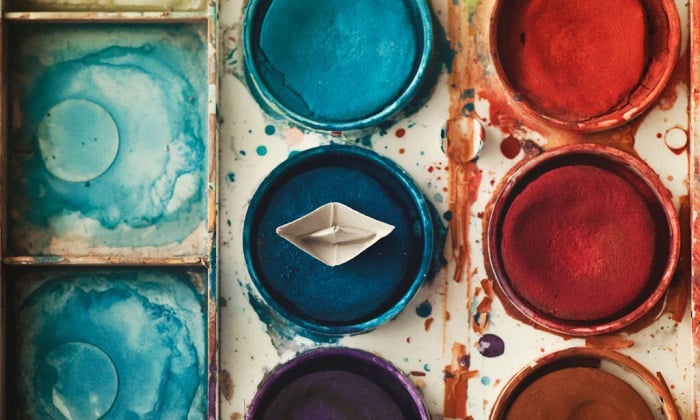
- Marine-grade paint
- Primer (epoxy recommended) and hardener
- Sandpaper (80-grit, 220-grit, and 400 grit)
- Cleaning cloth
- Masking tape
- Roller (or paint sprayer)
- PPEs such as gloves, a coat, and a respirator
Choose a workspace with good ventilation to avoid exposing yourself to fumes, which have many detrimental but highly avoidable side effects. Painting the boat on its trailer on a clear, dry day and positioning it so the paint won’t get direct sunlight exposure are ideal.
Practical Steps for Painting a Sailboat
This guide works well for fresh paint jobs and even if you’re repainting the boat.

Any dirt, debris, and grease should be taken care of in any sailboat paint job. Check for debris and algae clinging to the hull and the sailboat deck, and just use the brush and cloth to get it off.
Double-check parts of the keel because mud and seaweed tend to stick to it the most. If there are barnacles present, you may have to power wash them or any stubborn green stuff you encounter.
Dip the sponge in a mix of boat soap and water, then start scrubbing any stains. Afterward, give the sailboat a good rinse. Wait for it to dry.
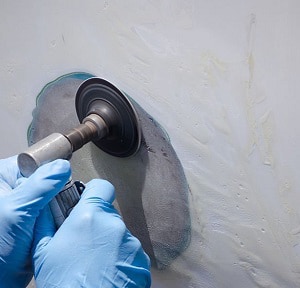
Put on your respirator and coat. Use an 80-grit or 100-grit to roughen the surface and remove any lingering trace of old paint by scrubbing in circular motions.
Then, grab the 220-grit to smoothen the surface more. That said, an 80-grit or 40-grit paired with a sander will do just as well, based on my experience every time I repaint a fiberglass boat .
You’d want the surface to be as even and smooth as possible before applying the first coat.

The epoxy primer helps to ensure that the paint will adhere well, too, so I recommend you don’t skip it. Epoxy also acts as a good sealant and prevents cracking and rust.
Before you apply it, put some masking tape over the areas of the hull that you don’t want the coats to go over. It will ensure even coats, too.
Every epoxy primer and hardener combination is different in one way or another. As such, follow what the manufacturer recommends when mixing. Be mindful of how quickly the mixture hardens.
Once you’re done with that step, use the roller to apply even coats of it over the whole surface of the hull. Depending on the size of your boat, this may take a while and can be tiring, so I suggest you ask for help.
Done? It’s time to wait a day to apply another layer. The next day, you can either apply another coat of primer (up to 4 coats is great) or proceed to the painting part.

Mix the paints according to the instructions.
You need to make sure the primer has dried before painting. I suggest two layers of topcoat followed by two equal coats of antifouling paint. But you can also skip to the antifouling paint immediately – your boat, your choice.
- Be sure to pick a good marine-grade paint like TotalBoat’s Alumipaint AF or Interlux’s Fiberglass Bottomkote Aqua. Better yet, you can just head to your local marine shop and ask for recommendations (trust me, they know their sailboat paint best).
- We’re not exactly doing something artsy here, like making an easy sailboat painting with acrylics. You want coats that can take a beating, so choose marine grade only.
Once you’re ready to work, use a roller or a sprayer to apply the paint. Personally, I’d suggest the latter choice because if you spray paint a boat, you’ll get a sleeker, more attractive finish, although it requires some skills.
Therefore, if you’ve never handled a sprayer, the best way to paint a boat would be with a roller. Here are some tips to ensure the best results:
- Pour the paint into the t
- Slightly dampen the roller with clean water.
- Lightly dip the roller into the paint so that no more than half of it is submerged.
- Run the roller on the paint tray’s ramp a few times to evenly distribute the pigment.
- Run the roller from the top to the bottom of the hull. Make sure you apply even pressure as you do so. Remember: the strokes should be parallel and uniform; under no circumstance should you change the stroke to a different pattern.
- Use a paintbrush to access cavities and holes on the hull that your roller can’t reach.
- Apply the suggested number of coats for each type of paint, taking care to sand with the 400-grit or higher with each However, make sure you confirm that it’s recommended by the paint’s manufacturer.
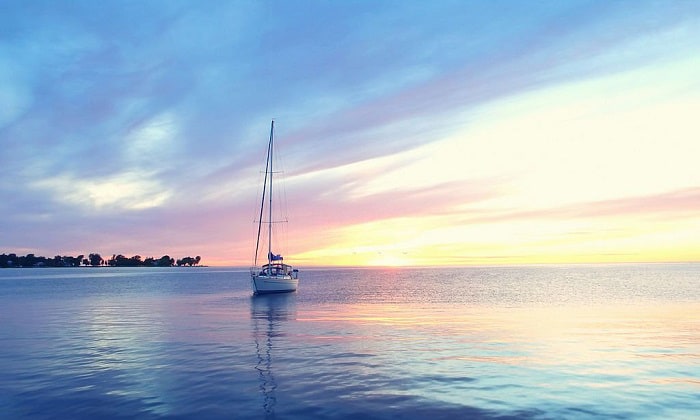
- The first is aesthetics. How can your gaze possibly not be arrested by an exquisitely painted sailboat sailing in the distance? It’s an automatic postcard image.
- Secondly but just as important (if not more), you’re protecting your baby from damage, barnacles, rot, and other nasty things, extending its life and boosting its value.
- It exercises your creativity. Try out some sailboat paint schemes available on sites like Pinterest, and you’ll know what I’m talking about.
I’ve certainly tried one or two of these ideas myself, but not on a skiff and jon boat that I made from scratch. My wife and buddies were positively mesmerized.
- Much like how videos on YouTube showing easy boat acrylic painting puts my mind at ease, I can say the same for when I’m painting sailboat hulls.
A lot of my friends who love to sail, fish, and paint sailboats on canvas say the same since they’re often more than willing to stop by and lend a helping hand during my paint days. We exchange sailboat painting ideas occasionally, and they like the method I’ve shared here.
As such, painting boats can be a way to relax your mind and help you connect with like-minded people. You may also learn helpful tips regarding sailing and boat maintenance along the way.
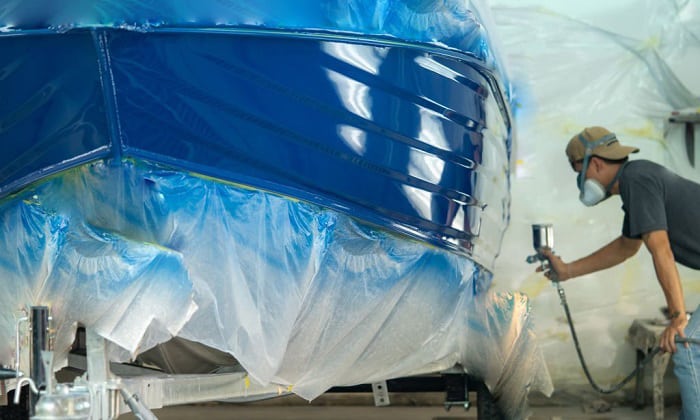
You need to paint your boat every year if you let it sit in the water all the time and the vessel shows signs of degradation.
That said, if you paint your sailboat with high-quality products, such as marine-grade paint, the coating can last for as long as 10 years, especially if you’re extra careful with your boat and have proper storage for it.
Besides the two brands I mentioned above, you can also try antifouling paints by Rust-Oleum. I just rotated between TotalBoat, Rust-Oleum, and Interlux because these three provided the best results among the sailboat paints I tested.
Rust-Oleum’s Topside Paint paired with the brand’s fiberglass primer work well with fiberglass hulls. But I can say the same for TotalBoat’s Topside Paint. To me, it’s really just whichever of the three is available on my local marine shop’s shelf. Besides choosing the right paint, you may also ask yourself how much it costs to paint a boat. Is it worth it? Check out this article to get the answer!

If you follow most of the preliminary preparatory steps I’ve shared here, you will be keeping yourself safe from start to finish.
- Wear the PPEs I said above every time you’re sanding and applying epoxy and paint on the surface.
- Read any warning labels on the paint and other chemicals you use, like acetone for drying the paint quickly. Handle it with care always.
- Learn how to dispose of your paint properly. It’d be even better if you learned how to recycle it.
- Beware of accidents that may happen while you’re doing the cleaning and prep work. I mean, I’ve hit my head on a sailboat mast while doing them, so I reckon the chance of such misfortunes happening isn’t zero, even on a paint job.
To recap everything I’ve said regarding how to paint a sailboat:
- Position your boat in a good workplace.
- Clean and sand its hull well using boat soap and water and sandpaper.
- Apply 4 coats of the primer, 2 coats of the topcoat, then 2 antifouling coats, or skip to the antifouling paint coat immediately.
- Decide how you’re going to apply the paint based on the finish you want and your skill in using each tool.
We wish you the best of luck with your painting project. If you want to share your results with us, feel free to reach out via the comment below.

“My intention from the first day establishing Boating Basics Online is to provide as much help as possible for boaters who want to experience a first safe and convenient trip. So feel free to join us and share your beautiful journeys to the sea!”


Claude Monet’s six most splendid paintings of sailboats
by Barista Uno | Nov 15, 2021 | Maritime Art, Culture and History

Sailboats held as much as fascination for French Impressionist master Claude Monet as water lilies and haystacks . He made several paintings of them. The following, in my opinion, are his most splendid works on the subject. They spotlight not only the beauty and elegance of sailboats. More importantly, they show Monet’s inimitable handling of colour, light and atmosphere.
“For me, a landscape does not exist in its own right, since its appearance changes at every moment; but the surrounding atmosphere brings it to life – the air and the light, which vary continuously. For me, it is only the surrounding atmosphere which gives subjects their true value.”
— claude monet, 1891 (as quoted by tate uk ).

Sailboat in Petit-Gennevilliers, 1874 Claude Monet (1840–1926) Courtesy of Wikimedia Commons
A sky exploding with wonderful colours and reflections on the serene waters of the Seine combine to transform an ordinary sailboat into something majestic.

Sailboats, regatta at Argenteuil, 1874 Claude Monet (1840–1926) Courtesy of Wikimedia Commons
Monet used the same pale palette for the sky, the sailboats and the river, adding tints of red for the houses to break the uniformity. Sky and water are dappled, and the boats are appear bunched together as they move gracefully along the river. All this gives the painting a peculiar kind of vitality and charm.

Le Havre, Fishing Boats Leaving the Port, 1874 Claude Monet (1840–1926) Courtesy of Wikimedia Commons
It’s a wet morning, but a crowd has gathered on the waterfront to watch the fishing boats sail out of the harbour to the open sea. The small figures in the foreground make the boats and their proud sails seem like multistoried buildings. This is captivating art with a narrative element.

Fishing Boats at Sea, 1868 Claude Monet (1840–1926) Courtesy of Wikiart: Visual Art Encyclopedia
Monet turned an ordinary day in the life of fishermen into a theatrical scene. The boat in the foreground is like an actor making his stage entrance as the curtain of day is raised. The two boats are rendered in dark brown to provide a contrast to the streaks of white light in the sky.

The Cliffs at Étretat, 1886 Claude Monet (1840–1926) Courtesy of Wikiart: Visual Art Encyclopedia
This painting — one of many done by Monet of the Étretat cliffs — is bursting with energy. Small patches of green, yellow and brownish orange are skillfully blended to create the impression of a dynamic but not choppy sea. The brightly coloured sky and the flotilla of small fishing boats accentuate the massive, towering cliffs.

Seascape, Storm, 1866 Claude Monet (1840–1926) Courtesy of The Clark, Massachusetts, USA
Seascape, Storm is an early work by Monet that is markedly different in style and technique from his later Impressionist paintings. In lieu of small, swift brushtrokes, the colours are applied solidly with some areas worked with a palette knife. The fishing boat is set against an ominous grey sky, and the sea is mostly a dark green. Just below the horizon line is a long strip of bright green, Monet suggesting perhaps that the storm will blow over, that there is hope.
You may also like
Art vs. reality: claude monet’s paintings of étretat.

Did you like this article? Buy me a coffee
Let us know what you think of this article.
If you like this site buy me a coffee

Recent Posts
- Sunset over water: The power of black & white
- ‘I am a feminist’: A male writer speaks up
- Sunsets at sea: Colour versus black & white photography
- Which is correct: ‘in a boat’ or ‘on a boat’?
- Women in boats: A celebration of beauty
Don't Miss the Brew!
Sign up to be notified of updates to Marine Cafe Blog
You have Successfully Subscribed!
Pin it on pinterest.
- How to paint a boat: A step-by-step guide
Painting your boat not only enhances its visual appeal but also protects it from the damaging effects of saltwater, sunlight, and other elements. Whether you have a sailboat, powerboat, or kayak, the principles of boat painting remain largely the same.
Assessing your boat's condition
Before you begin, evaluate your boat's current condition. Inspect the hull for any damage, scratches, or rust that may need to be addressed before painting. Make a list of necessary repairs and tackle them first.
Gathering the right tools and materials
To paint your boat successfully, you'll need a range of tools and materials, including paintbrushes, rollers, sandpaper, masking tape, drop cloths, and, most importantly, the appropriate marine paint.
Preparing the boat surface
Proper preparation is the key to a successful paint job. Start by cleaning the boat's surface thoroughly to remove dirt, grease, and old paint. Sand the surface to create a smooth and clean canvas for the new paint to adhere to.
Applying primer
Priming is a crucial step to ensure good paint adhesion and durability. Apply a marine-grade primer that is compatible with the paint you've chosen. Allow it to dry thoroughly as per the manufacturer's instructions.
Read our top notch articles on topics such as sailing, sailing tips and destinations in our Magazine .
A man taking care of his ship.
Check out our latest sailing content:
Introduction to chartering with a skipper, traditional sailor tattoos: meaning of the swallow, the most popular catamarans of 2023, explore tuscan archipelago in one week, skippered boats: how to pack for a yachting holiday, boat rental with skipper: everyone can go to sea, skippered boats: myths about sailing, sail from lefkada for 14 days. where to, what not to miss when visiting lefkada, skippered boats: step-by-step boat rental, where and why to sail from lefkas marina, don’t panic: handling maritime emergencies, skippered boats: how to choose a boat, the best sailing routes from biograd na moru, yachting away from ourselves: a voyage to inner peace, sail to the 7 most beautiful sights in greece, skippered boats: how to put together a crew, skippered boats: the most popular yachting destinations, what skipper's licence do i need, skippered boats: what you can experience when yachting, from lefkada or corfu to paxos and antipaxos, discover the paradise of paxos and antipaxoss, skippered boats: typical day on board, skippered boats: what it actually looks like on a boat, discover corfu: sailing adventure in the ionian, sextant and navigation: survival without gps, 5 best sailing routes in the bahamas, skippered boats: how much does a boat holiday cost, yachting guide to the bahamas, the ultimate yacht cleaning kit, choosing the right paint.
Selecting the right type of marine paint is essential. There are different types of boat paint available, such as antifouling paint, topside paint, and bottom paint. Choose the one that suits your boat's needs and your intended use.
Applying the paint
Start by applying the paint to the boat's surface using a paintbrush or roller. Use long, even strokes, working from one end to the other. Be mindful of the weather conditions, as extreme temperatures and humidity can affect the paint's drying process.
Applying additional coats
For best results, you may need to apply multiple coats of paint. Follow the manufacturer's recommendations for drying times between coats. Applying multiple thin coats is often better than one thick coat.
Drying and curing
Allow the paint to dry completely before launching your boat into the water. The curing time can vary depending on the type of paint and environmental conditions. Follow the paint manufacturer's instructions for specific guidance.
Final touches and cleanup
After the paint has dried, remove any masking tape and clean your tools and equipment. Inspect your boat's finish for any imperfections, and make any necessary touch-ups.
Painting a boat requires careful planning, preparation, and attention to detail, but the results can be incredibly rewarding. Not only will your boat look like new, but it will also be better protected against the elements, ensuring many more enjoyable days on the water.
Whether you're a DIY enthusiast or a boat owner looking to maintain your vessel's beauty and functionality, this step-by-step guide on how to paint a boat will help you achieve a professional and long-lasting finish. So, roll up your sleeves, gather your materials, and give your boat the makeover it deserves. Happy painting!
So what are you waiting for? Take a look at our range of charter boats and head to some of our favourite sailing destinations.
I am ready to help you with booking a boat for your dream vacation. Contact me.

Denisa Nguyenová
Original Fine Art Sailboat Paintings For Sale
Browse art and see similar matches
Try Visual Search
Impressionism
Expressionism
Abstract Expressionism
Contemporary
Illustration
Photorealism
Documentary
Portraiture
Spray Paint
Black & White
Dye Transfer
Soft (Yarn, Cotton, Fabric)
23 3/4 Carat Gold Leaf
High Quality Professional Oil Art Paints, Italian Linen Canvas, Covered With Protective Varnish
$500 - $1,000
$1,000 - $2,000
$2,000 - $5,000
$5,000 - $10,000
Over $10,000
Orientation
Artist country.
United States
United Kingdom
Netherlands
Switzerland
Czech Republic
Bosnia And Herzegovina
South Korea
New Zealand
Featured Artist
Saatchi Art Catalog
Inside The Studio
Rising Stars
One To Watch
The Other Art Fair
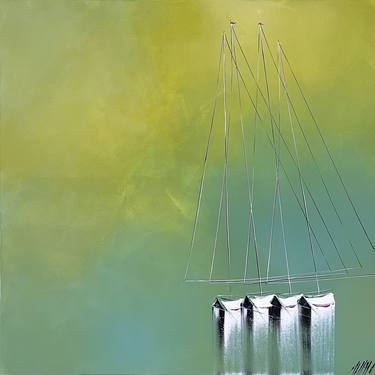
Espoir à l'horizon... "HOPE AT THE HORIZON..." (2023)
Paintings , 31.5 W x 31.5 H x 0.8 D in
Olivier Messas

Love the sea no. 5822 black + white + copper
Paintings , 59.1 W x 39.4 H x 1.6 D in
Anita Kaufmann

Horizon d’été... | « SUMMER HORIZON... »
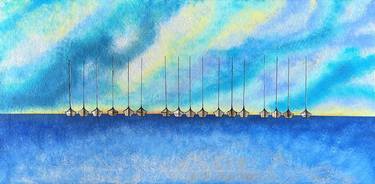
sunrise (series: symphony)
Paintings , 39.4 W x 19.7 H x 1.6 D in
Martina Niederhauser-Landtwing
Prints from $59
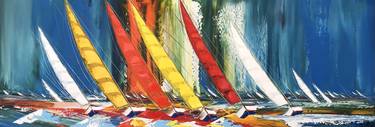
Évasion en mer... | « Escape at sea... » (SAILING SPIRIT 2021)
Paintings , 78.7 W x 27.6 H x 2 D in
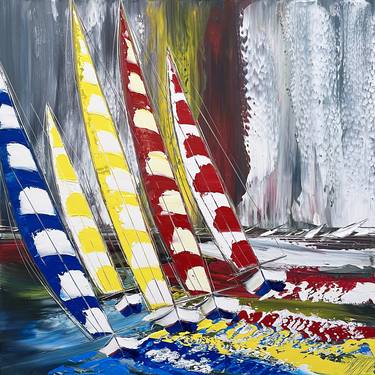
Couleurs en mer... "COLORS AT SEA" (SAILING SPIRIT 2022)
Paintings , 39.4 W x 39.4 H x 0.8 D in
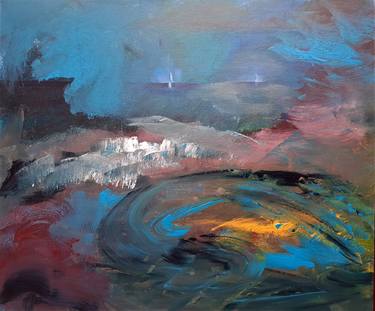
Sailing away
Paintings , 23.6 W x 19.7 H x 0.8 D in
Elena Ivanova
Prints from $240
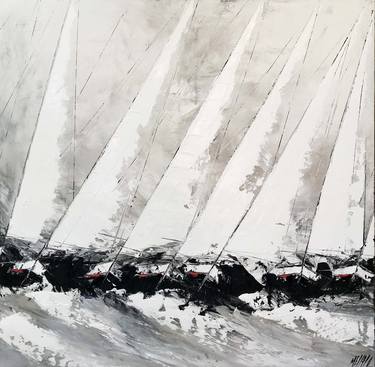
Les voiles de Saint-Tropez
Paintings , 55.1 W x 55.1 H x 0.8 D in
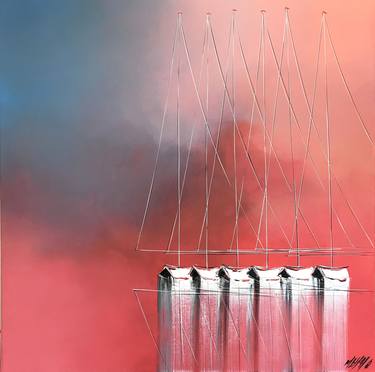
Le temps d'un coucher de soleil... "WHEN THE SUN GOES DOWN..."
Jeux de reflet... | « REFLECTION GAMES... » (2017)
Paintings , 47.2 W x 15.7 H x 0.8 D in
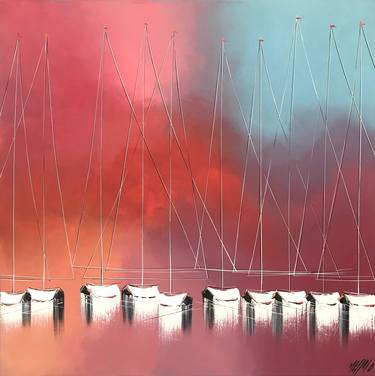
Un soir d’été ... | “A SUMMER EVENING...”
Jeux de reflets... "REFLECTIONS" (SAILING SPIRIT 2021)
Petit voilier marbré et or | "SAILBOAT GOLD & MARBLED"
Paintings , 6.3 W x 11 H x 0.1 D in
Duo en mer... "THE TWO OF US AT SEA..." (2024)
Paintings , 15.7 W x 19.7 H x 0.8 D in
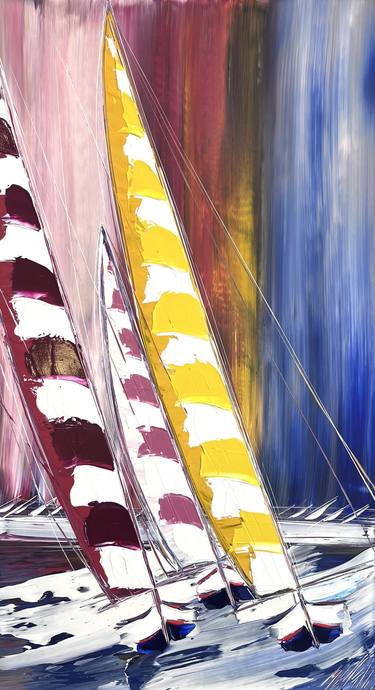
Sur les vagues... "ON THE WAVES" (SAILING SPIRIT 2023)
Paintings , 19.7 W x 39.4 H x 0.8 D in
Prints from $40

Course en mer... "RACE AT SEA" (SAILING SPIRIT 2023)
Paintings , 39.4 W x 51.2 H x 0.8 D in
Prints from $49

Horizon d'éternité... "HORIZON OF ETERNITY" (2022)
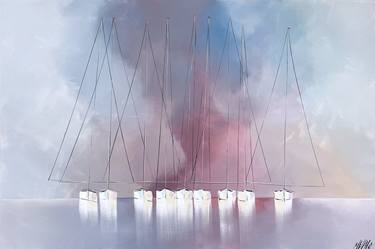
Rêverie... "DREAM" (SAILING SPIRIT 2022)
Paintings , 47.2 W x 31.5 H x 0.8 D in

Régate à l'horizon... | "RACE AT THE HORIZON..."
Paintings , 70.9 W x 19.7 H x 0.8 D in
Contre vent et marée... | « AGAINST WIND AND LOW TIDE... »
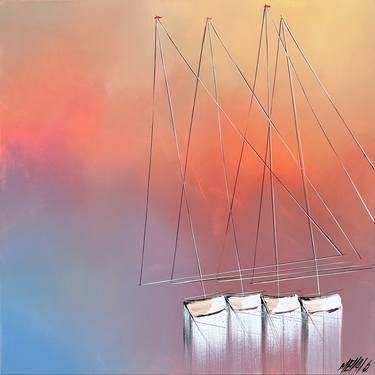
Aux premières lueurs de l’aube... "DAWN" (2023)
Paintings , 23.6 W x 23.6 H x 0.8 D in
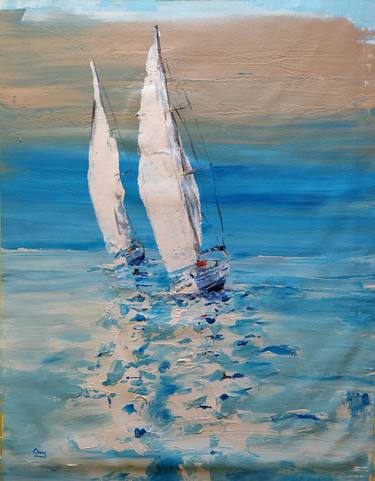
Paintings , 26.4 W x 33.9 H x 0.1 D in
OSCAR ALVAREZ
Prints from $100
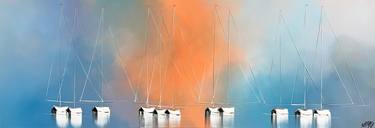
Silence en mer... | "SILENCE AT SEA..."
Paintings , 68.9 W x 23.6 H x 0.8 D in
the pink sky (symphony series)
Paintings , 39.4 W x 9.8 H x 1.6 D in
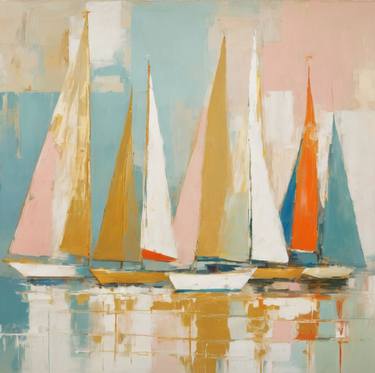
Sailing Dreamscape
Paintings , 23 W x 23 H x 1.5 D in
Alexandra Papadopoulou
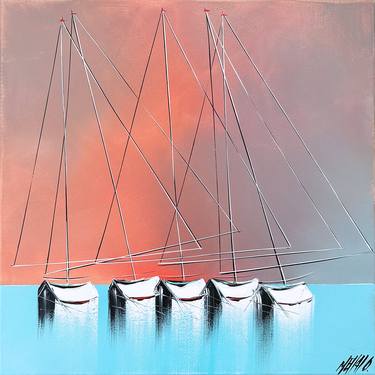
Mettre les voiles.. "SAIL OFF INTO THE SUNSET..." (2024)
Paintings , 19.7 W x 19.7 H x 0.8 D in
Blue lakescape
Paintings , 11.8 W x 9.4 H x 0.8 D in
Atelier BDGB
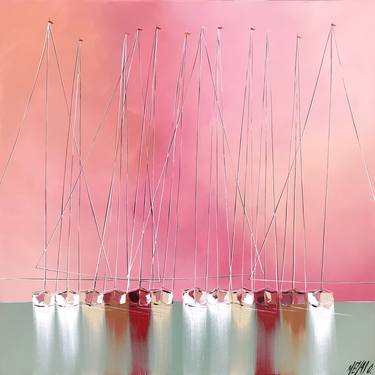
Ensemble... "TOGETHER..." | SAILING SPIRIT 2022
Été indien... | "INDIAN SUMMER..."
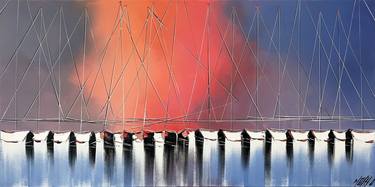
Les mâts du soleil Levant... "THE MASTS OF THE RISING SUN"
Paintings , 39.4 W x 19.7 H x 0.8 D in

Aux premières lueurs du jour... | "AT SUNRISE..."

Les mâts de l’horizon... | "MASTS AT THE HORIZON..."
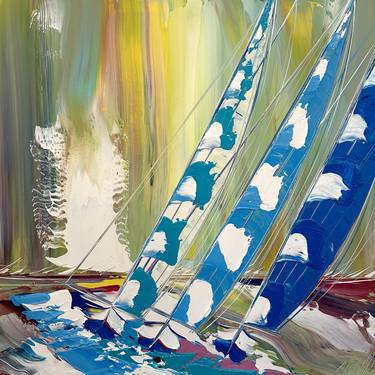
Voile en Bretagne... « SAILING IN BRETTES ANY..."
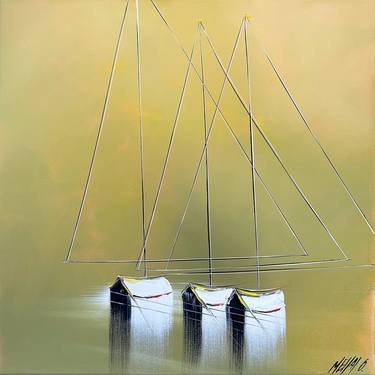
Naviguer ensemble... "SAILING TOGETHER..." (SAILING SPIRIT 2023)
Prints from $43
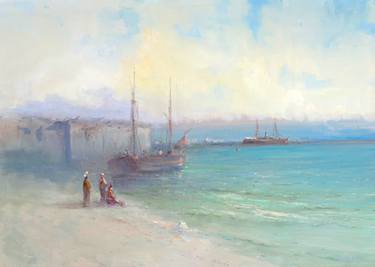
Paintings , 39.5 W x 28.5 H x 0.8 D in
Karen Darbinyan
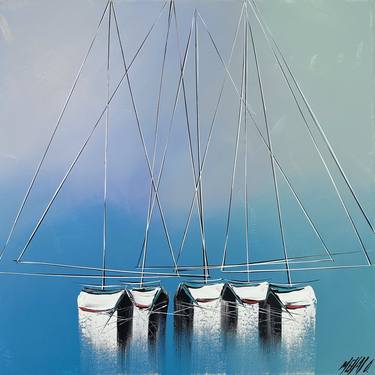
Les mâts du grand bleu.. "THE MASTS OF THE OCEAN..." (2024)

Harbor Life
Paintings , 23.6 W x 31.5 H x 1.2 D in
Jelena Djokic
Prints from $84
Les couleurs du printemps... | "THE COLORS OF SPRING... » (2019)
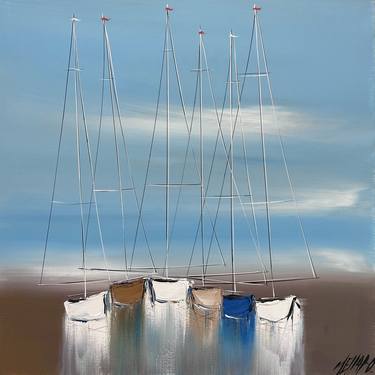
Le temps suspendu.. "THE SUSPENDED TIME..." (SAILING SPIRIT 2024)
La nuit des voiliers... | "THE NIGHT OF SAILBOATS..." (SAILING SPIRIT 2018)
Paintings , 47.2 W x 15.7 H x 0.1 D in
dream higher than the sky
Paintings , 47.2 W x 13.8 H x 1.6 D in
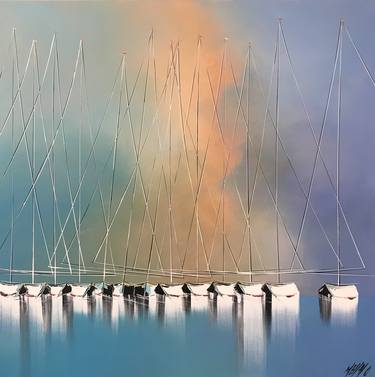
À bon port... | « IN THE SAFE HARBOUR... »

Paintings , 19.7 W x 25.6 H x 0.1 D in
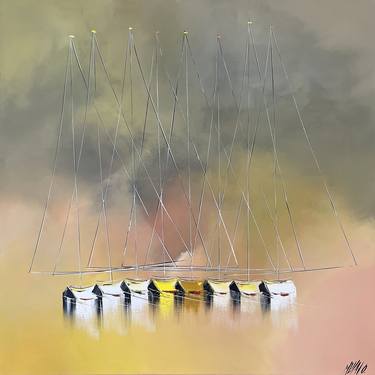
Romance... "ROMANCE..." | SAILING SPIRIT 2022
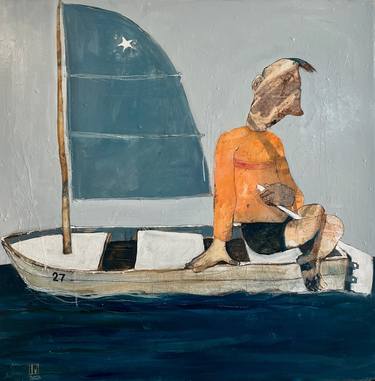
Future Team New Zealand
Paintings , 41.3 W x 41.3 H x 2.8 D in
ILYA VOLYKHINE

Paintings , 20 W x 20 H x 1.6 D in
Sophia Oshodin
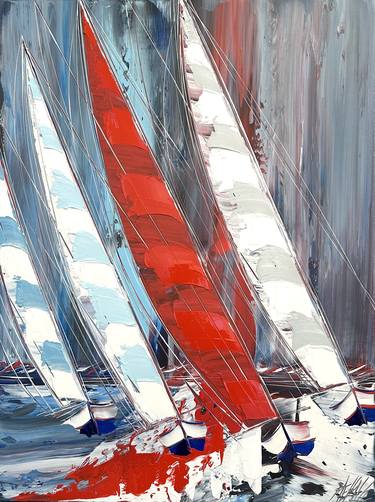
La voile rouge… “THE RED SAIL” (2023)
Paintings , 23.6 W x 31.5 H x 0.8 D in
Couleurs à l'horizon... "COLORS AT THE HORIZON..."
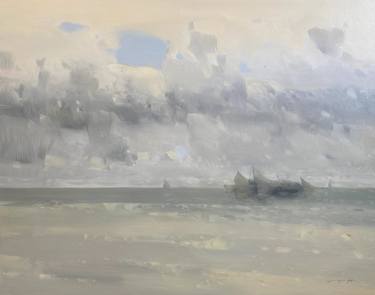
Paintings , 56.5 W x 44 H x 1 D in
Vahe Yeremyan
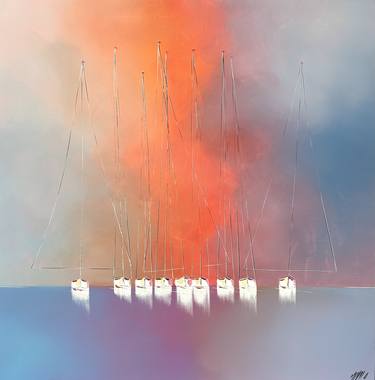
Coucher de soleil... "SUNSET..." (2023)
Paintings , 51.2 W x 51.2 H x 0.8 D in
1 - 50 of 426 paintings

Famous Ship Paintings – Best Nautical Paintings of Ships at Sea
Paintings of ships at sea are among the iconic artworks in the world. For centuries, numerous civilizations ruled the world’s waters, sending commercial vessels and ships of war out into the blue horizon; as a result, marine art emerged to depict these adventures and battles. Today, we will celebrate these famous ship paintings and boat paintings by giving them a deeper look.
Table of Contents
- 1.1 The Storm on the Sea of Galilee (1633) by Rembrandt
- 1.2 The Home Fleet Saluting the State Barge (1650) by Jan van de Cappelle
- 1.3 Nelson’s Inshore Blockading Squadron at Cadiz (1797) by Thomas Buttersworth
- 1.4 Battle of Trafalgar (1805) by Louis Philippe Crepin
- 1.5 A First Rate Man-of-War Driven Onto a Reef of Rocks, Floundering in a Gale (1826) by George Philip Reinagle
- 1.6 The Fighting Temeraire (1839) by J. M. W. Turner
- 1.7 Becalmed off Halfway Rock (1860) by Fitz Hugh Lane
- 1.8 Red Boats, Argenteuil (1875) by Claude Monet
- 1.9 Breezing Up (A Fair Wind) (1876) by Winslow Homer
- 1.10 Fishing Boats on the Beach at Saintes-Maries (1888) by Vincent van Gogh
- 2.1 Why Are Paintings of Ships at Sea Such a Popular Topic?
- 2.2 What Do Famous Ship Paintings Portray?
Our Favorite Famous Ship Paintings
Nautical paintings commemorate the incredible vessels that once sailed the seas, as well as more subdued sailboat paintings. Over time, these vessels became the lifeline of the economies of nations such as the United Kingdom and Portugal, with their sailors carrying and delivering valuable goods of various types. For over a thousand years, ships of diverse kinds and sizes have sailed the oceans.
Part of what inspires the adoration of so many art lovers and aficionados, especially in coastal areas, is the contrast between brilliant man-made ships and the unpredictability and dangers of the ocean and Mother Nature herself.
Many painters have experimented with creating nautical paintings and their legendary sea excursions throughout history, with others specializing entirely in the theme of nautical travel. Here are our favorite paintings of ships at sea.
The Storm on the Sea of Galilee (1633) by Rembrandt
| (1606 – 1669) | |
| 1633 | |
| Oil on canvas | |
| 160 x 128 | |
| Stolen |
This well-known marine artwork was looted in 1990 from the Isabella Stewart Gardner Museum. The boat painting’s whereabouts are still unknown, and it might never be found again. However, there is some debate around the work. It has been the focus of various theft-related investigations ever since it vanished. During the 1630s, just as Rembrandt arrived in Amsterdam to start his professional career, he created what many believe to be his most dramatic works.
This artwork is an example of this period. Rembrandt picked a Bible narrative to demonstrate the seriousness of his creative ambitions.
Rembrandt moved to Amsterdam with the intention of being recognized for his historical artworks and portraits. Using a New Testament narrative, he illustrated how to blend a historical picture with a seascape. This New Testament incident would have been recognizable to Rembrandt’s contemporaries and, more than likely, admired by them. The suspense produced in the picture, on the other hand, would present the narrative with a totally new and surprising interpretation. This example of innovation and risk-taking by Rembrandt, then 27 years old, set him apart from his colleagues and became the foundation of his creative growth.
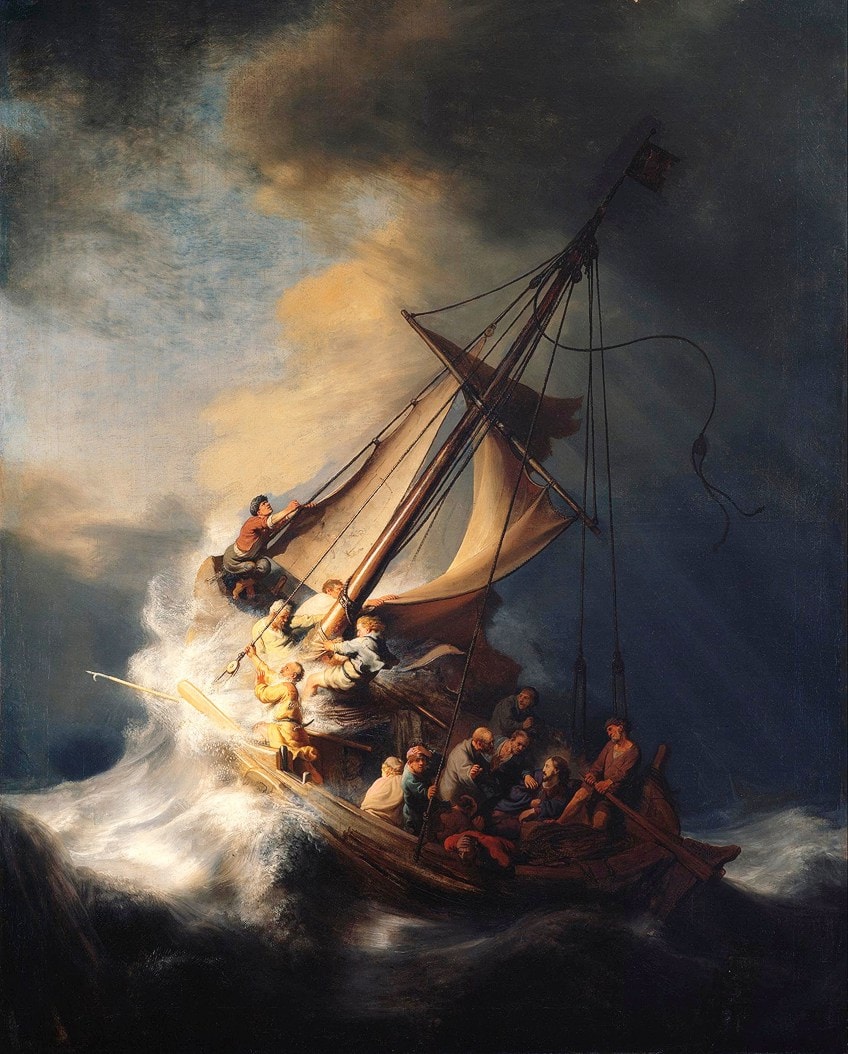
The Home Fleet Saluting the State Barge (1650) by Jan van de Cappelle
| Jan van de Cappelle (1624 – 1679) | |
| 1650 | |
| Oil on panel | |
| 64 x 92.5 | |
| Rijksmuseum, Amsterdam, Netherlands |
As numerous pilgrims and travelers journeyed to the New World across the Atlantic Ocean in the mid-1600s, seafaring transportation was responsible for shaping the world’s individuals and nations. In his 1650 marine artwork, Jan van de Cappelle caught one significant event from this time period. The picture portrays a variety of ships gathered in a port to honor a major vessel as it set off on its trip.
Cappelle’s artwork is considered among the most famous ship paintings because he captures the water’s capacity to reflect events above its surface in exquisite clarity.
Jan van de Cappelle was a painter of winter landscapes and paintings of ships at sea from the Dutch Golden Age , as well as an entrepreneur and art collector. He is widely regarded as the greatest marine artist of 17th-century Holland.
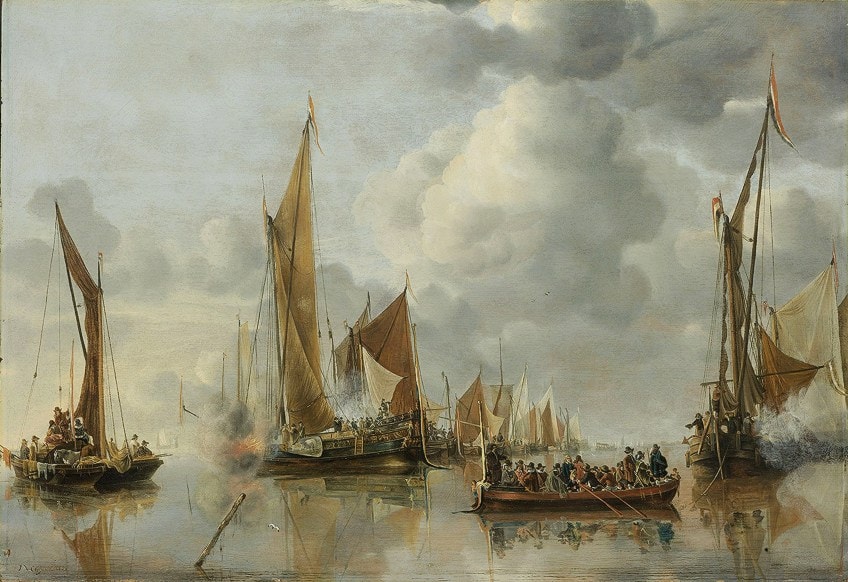
Nelson’s Inshore Blockading Squadron at Cadiz (1797) by Thomas Buttersworth
| Thomas Buttersworth (1768 – 1842) | |
| 1797 | |
| Oil painting | |
| 63.5 x 99 | |
| National Maritime Museum, London |
During the second part of the 18th century, the British Royal Navy was at the pinnacle of its nautical power throughout most of Europe and the rest of the world. During this period, the nation’s formidable navy fought in several conflicts off the coast of Portugal as the two countries competed for supremacy of the waterways around coastal Europe and other regions of the Atlantic. In 1797, Thomas Buttersworth produced this picture commemorating a decisive naval fight for British forces off the coastline of Portugal.
Following the historic Battle of St. Vincent, Nelson and ten bargemen were conducting a night attack against Spanish gunboats.
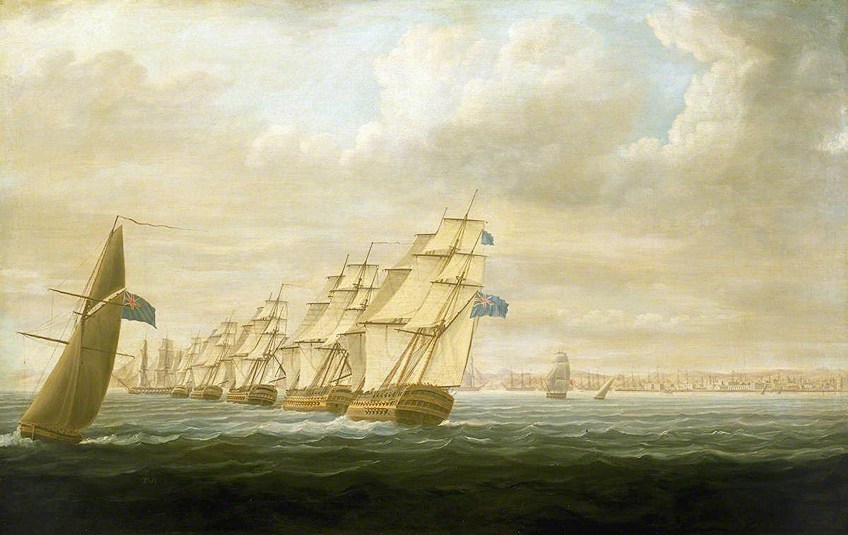
Battle of Trafalgar (1805) by Louis Philippe Crepin
| Louis Phillipe Crepin (1772 – 1851) | |
| 1805 | |
| Oil on canvas | |
| 90.93 x 80.78 | |
| National Maritime Museum, Greenwich, London |
A number of the most famous ship paintings depict bloody sea conflicts between formidable naval forces. This is true of Louis Phillipe Crepin’s 1805 work. This picture shows one of the most well-known naval battles, which occurred in the year the artwork was made. The fight faced the formidable British Royal Navy against two other worthy adversaries—the French and Spanish naval forces—who had collaborated to try to overthrow the overwhelming force that had controlled the waterways surrounding Europe and most of the world at the time.
Crepin’s picture depicts the close-quarters warfare that was common in naval conflicts with exceptional precision.

A First Rate Man-of-War Driven Onto a Reef of Rocks, Floundering in a Gale (1826) by George Philip Reinagle
| George Philip Reinagle (1802 – 1835) | |
| 1826 | |
| Oil on canvas | |
| 102 x 127.2 | |
| Royal Albert Memorial Museum, Exeter |
The early 1800s were most likely the peak of the legendary ship painting era. George Philip Reinagle was a well-known marine artist noted for his ability to portray the character of the sea’s often violent nature that has wrecked so many big, strong ships throughout history.
His 1826 masterpiece is adequately titled since it depicts a ship caught in the grasp of the surging sea.
One of the most exciting features of maritime travel was the risk that mariners may perish if caught in a raging storm, sometimes known as a gale. This work is famous for Reinagle’s ability to capture the massive, crushing power of the waves, as well as the sea spray whipped up by the fierce winds. This piece serves as a sobering reminder that not all marine exploration and adventure are safe.
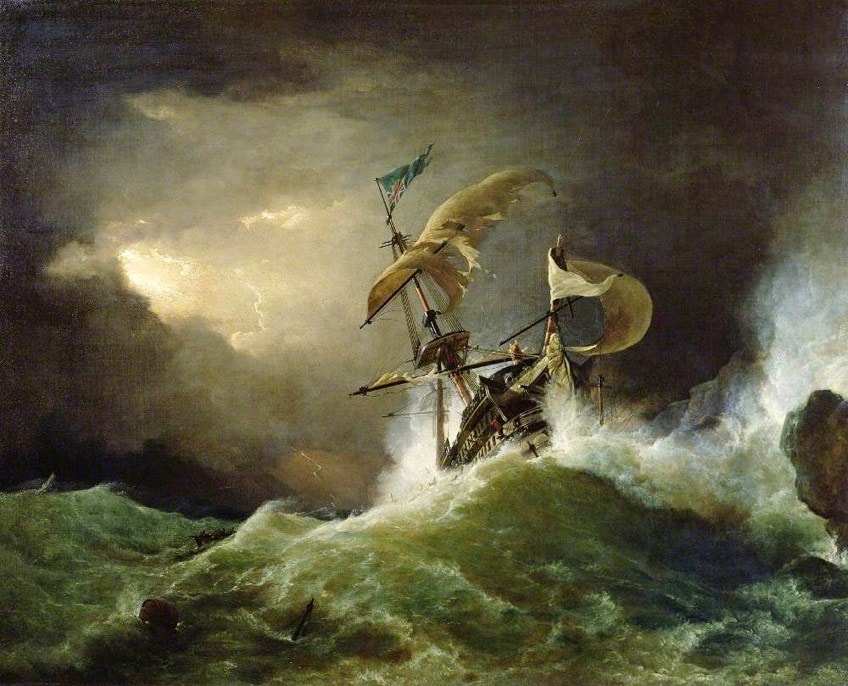
The Fighting Temeraire (1839) by J. M. W. Turner
| J. M. W. Turner (1775 – 1851) | |
| 1839 | |
| Oil paint | |
| 90.7 x 121.6 | |
| National Gallery, London |
The early industrial revolution is suggested by the marine artwork’s surroundings. Even though the sky is illuminated, a tugboat is rushing to assist. The tugboat stands for the new era of steam, coal, and fire. Turner’s own emotions and imagination are revealed in the image, which is intriguing and romantic. Although it is difficult to determine the painting’s message, it is unquestionably an important symbol of its time.
Turner’s boat painting features opposing hues that give it a magical or ethereal appearance. In contrast to the gloomy sky, the tugboat pops out.
A little portion of the painting’s bottom is taken up by the water, striking a balance between the sky and water. The Fighting Temeraire , while not well-liked in its day, has grown in popularity over time. A significant character in British art history, John Ruskin, spoke favorably of the piece. Although the artwork was eventually taken off the auction board, many reviewers, including Turner himself, praised it as a masterpiece. Nevertheless, Turner kept promoting his work despite the numerous unfavorable reviews.
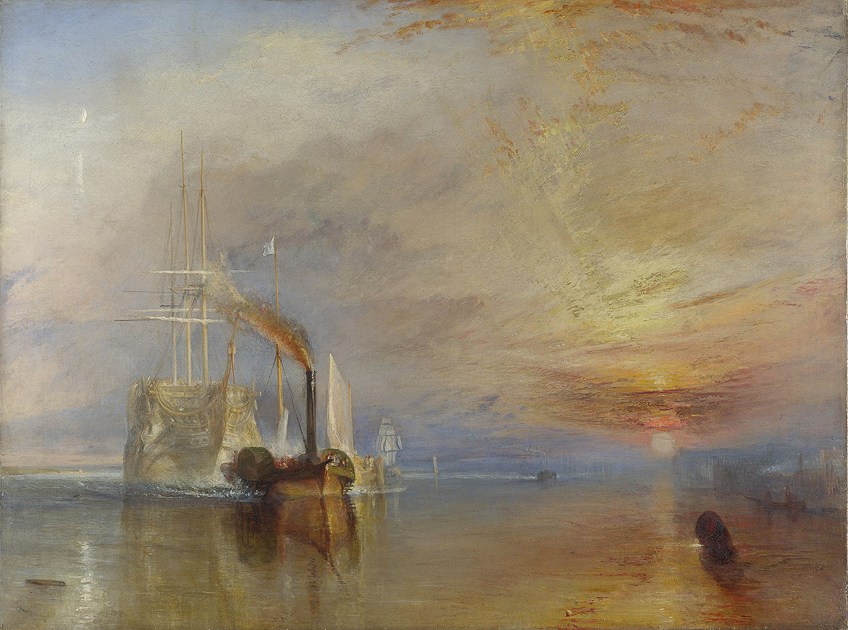
Becalmed off Halfway Rock (1860) by Fitz Hugh Lane
| Fitz Hugh Lane (1804 – 1865) | |
| 1860 | |
| Oil on canvas | |
| 70.4 x 120.5 | |
| National Gallery of Art, Washington, DC |
Several of the most famous ship paintings ever made depict warships engaged in furious conflicts or stuck in tremendous gales on the wide sea. There are, though, a few significant nautical paintings that reflect the placid, quiet character of the ocean or coastal regions. This piece portrays ships tied around Halfway Rock, a prominent maritime landmark located roughly halfway between Cape Ann and Boston.
This place was a popular stopping point for commercial vessels and supply ships since it allowed them to connect with other ships and conduct many forms of maritime commerce at a precise spot.
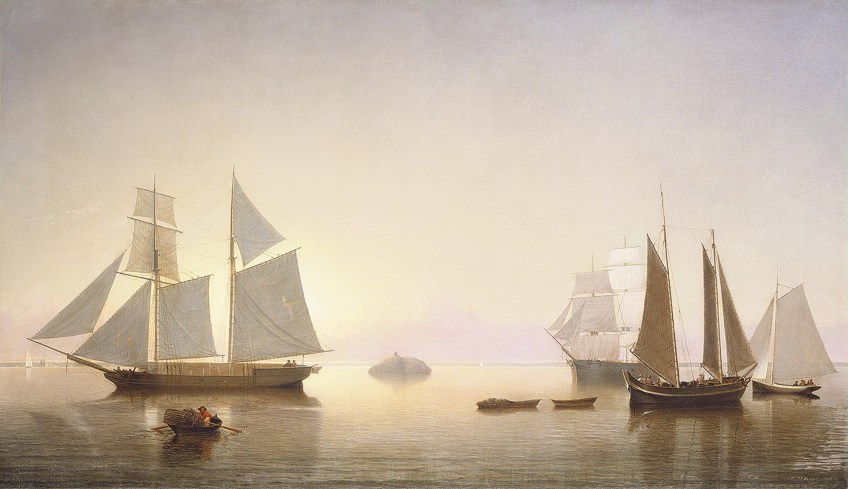
Red Boats, Argenteuil (1875) by Claude Monet
| Claude Monet (1840 – 1926) | |
| 1875 | |
| Oil painting | |
| 61.8 x 82.5 | |
| Musée d’Orsay, Paris, France |
Monet depicted the town and outlying areas of Argenteuil during the 1870s, creating images of harmony and beauty that were sometimes at odds with the realities of the time. Despite his belief in en Plein air painting , Monet painstakingly selected the components he wanted to incorporate and often completed his works in the studio.
His works include no hints of the contamination of the river at Argenteuil or the chaos of a community pushing all into its industry.
Monet created the composition in this painting by using boats, particularly the verticals of the masts. Again, he used contrasting colors in the form of oranges, blues, greens, and reds. The painting is vibrant with color, and the blues and purples depict the depth of the sea.
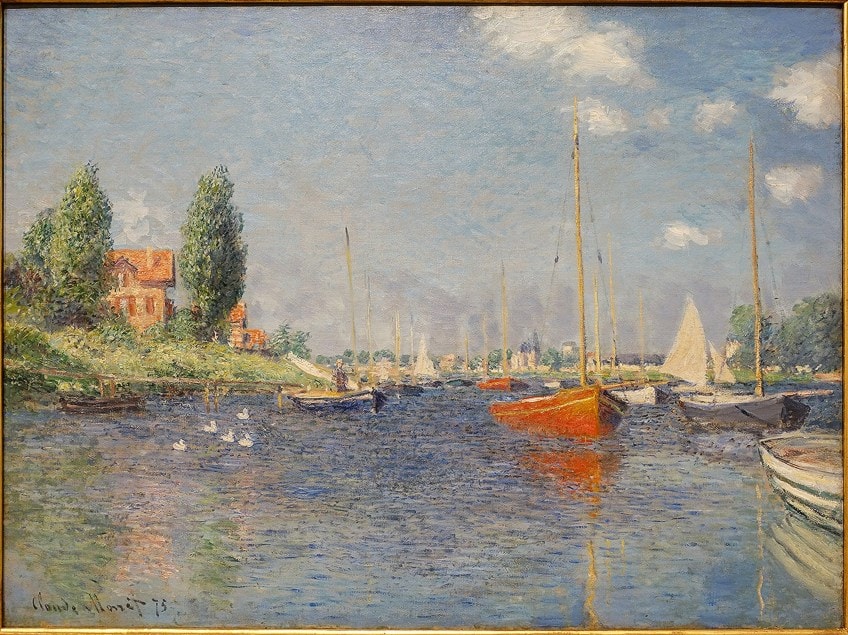
Breezing Up (A Fair Wind) (1876) by Winslow Homer
| Winslow Homer (1836 – 1910) | |
| 1876 | |
| Oil on canvas | |
| 61.5 x 97 | |
| National Gallery of Art, Washington, DC |
After visiting Massachusetts, where he first painted in watercolor, Homer started this painting in New York in 1873. He utilized the sketches he made there to create an oil painting that he worked on for three years. Infrared reflectography has shown the several composition modifications he made during this period, including the erasure of a fourth youngster near the mast and a second ship in the distance.
The artwork’s theme is upbeat; despite the turbulent seas, the boaters appear to be at ease. The anchor that substituted the person in the bow was said to represent hope.
The youngster at the helm looks to the horizon, an expression of hope for his and the nascent United States’ future. The final piece demonstrates that Homer was influenced by the substantial impact of Japanese art on Western artists in the 19th century, notably in the compositional balance between the dynamic and sparse parts. In 1866, Homer visited France, and the influence of French artists Claude Monet and Gustave Courbet’s nautical paintings is also visible.
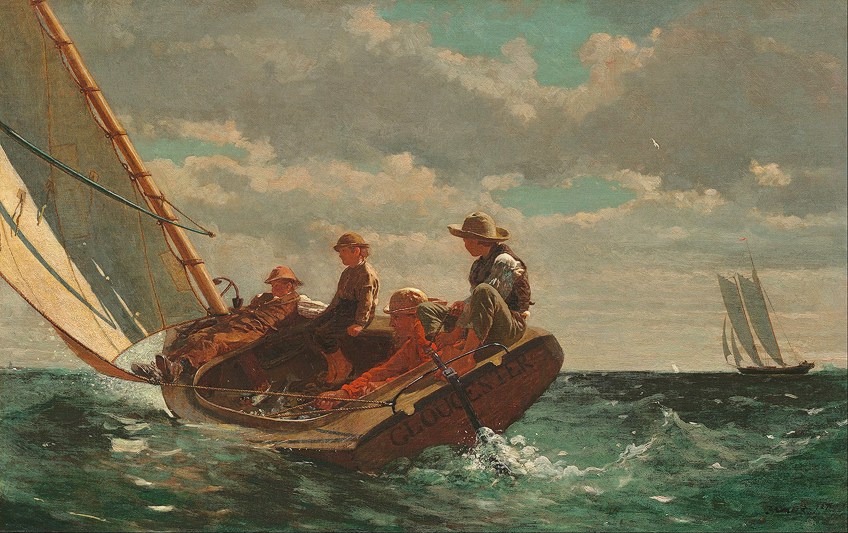
Fishing Boats on the Beach at Saintes-Maries (1888) by Vincent van Gogh
| Vincent van Gogh (1853 – 1890) | |
| 1888 | |
| Oil on canvas | |
| 39.5 x 53.3 | |
| Van Gogh Museum, Amsterdam |
This sailboat painting is a reworking of the artist’s drawing and is one of his most impressive attempts at establishing balance and harmony. The fishing boats stand in sharp contrast to his condition, serving as a source of optimism for the painter as he neared the end of his life. Vincent van Gogh applied his colors with a palette knife, and the contrasting blue and white portions of the water are filled with greens and blues to form the waves. He also produced the boats with a reed pen and added the white and blue colors with big scribbles.
As a result, the picture has a flowing movement and a blend of Impressionist and Realism elements.

Warship and sailboat paintings have always been popular subjects. This is likely due to the fact that ships have played such an important role in the development of civilization. Thanks to artists who are fascinated with these incredible vessels, we have many famous ship paintings to admire nowadays.
Take a look at our ship paintings webstory here!
Frequently Asked Questions
Why are paintings of ships at sea such a popular topic.
Ships have played an essential role in the past for humans, helping us explore new lands and peoples. Perhaps it is this sense of adventure and free spirit that artists personally resonate with. Or perhaps creating nautical paintings provides them with the chance to portray both nature and man-man creations.
What Do Famous Ship Paintings Portray?
Some artists depict intense battle scenes from human history. Others prefer to create sailboat paintings that have a more subdued and peaceful atmosphere. Other times, the artwork can have a biblical or mythological tale attached to it. Paintings of ships at sea are not only numerous but diverse in their themes and styles.

Isabella studied at the University of Cape Town in South Africa and graduated with a Bachelor of Arts majoring in English Literature & Language and Psychology. Throughout her undergraduate years, she took Art History as an additional subject and absolutely loved it. Building on from her art history knowledge that began in high school, art has always been a particular area of fascination for her. From learning about artworks previously unknown to her, or sharpening her existing understanding of specific works, the ability to continue learning within this interesting sphere excites her greatly.
Her focal points of interest in art history encompass profiling specific artists and art movements, as it is these areas where she is able to really dig deep into the rich narrative of the art world. Additionally, she particularly enjoys exploring the different artistic styles of the 20 th century, as well as the important impact that female artists have had on the development of art history.
Learn more about Isabella Meyer and the Art in Context Team .
Cite this Article
Isabella, Meyer, “Famous Ship Paintings – Best Nautical Paintings of Ships at Sea.” Art in Context. November 23, 2022. URL: https://artincontext.org/famous-ship-paintings/
Meyer, I. (2022, 23 November). Famous Ship Paintings – Best Nautical Paintings of Ships at Sea. Art in Context. https://artincontext.org/famous-ship-paintings/
Meyer, Isabella. “Famous Ship Paintings – Best Nautical Paintings of Ships at Sea.” Art in Context , November 23, 2022. https://artincontext.org/famous-ship-paintings/ .
Similar Posts

“Virgin of the Rocks” by Leonardo da Vinci – The Iconic Artwork

Le Déjeuner sur l’herbe – Looking at Manet’s “Luncheon on the Grass”

“Isenheim Altarpiece” by Matthias Grunewald – A Deep Look

“The Lament for Icarus” by Herbert James Draper – An Analysis

Famous Picasso Paintings – Analyze His 12 Must-See Artworks
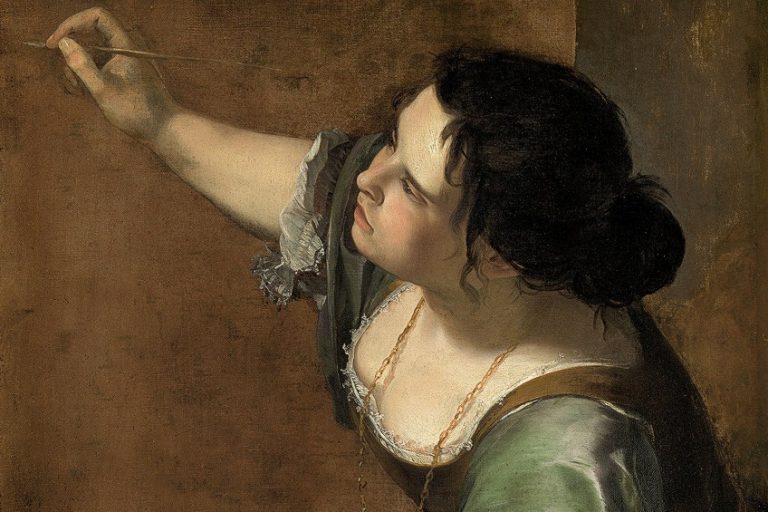
Artemisia Gentileschi Paintings – The Queen of the Baroque
Leave a reply cancel reply.
Your email address will not be published. Required fields are marked *
Save my name, email, and website in this browser for the next time I comment.
The Most Famous Artists and Artworks
Discover the most famous artists, paintings, sculptors…in all of history!

MOST FAMOUS ARTISTS AND ARTWORKS
Discover the most famous artists, paintings, sculptors!

- BOAT OF THE YEAR
- Newsletters
- Sailboat Reviews
- Boating Safety
- Sails and Rigging
- Maintenance
- Sailing Totem
- Sailor & Galley
- Living Aboard
- Destinations
- Gear & Electronics
- Charter Resources

How to Paint Sailboat Decks
- By Tom Zydler
- Updated: March 14, 2013
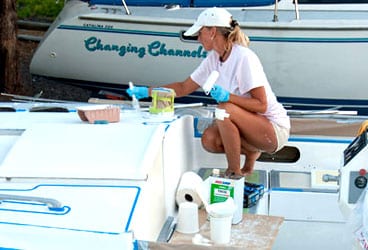
Painting a sailboat
Janet Van Leuwen and Steve Van Wig own a Whitby 42. Looking at their beautiful, well-groomed ketch, you’d never guess it was built in 1982. The name on the stern, Lunacy , may be the only hint of the incredible amount of work that the couple has put into rejuvenating their boat. Bringing the decks and the coachroof top to their present glory was a large part of the project, as these tasks would’ve been on any glass boat more than 25 years old. This is how they did it. And frankly, this is how it should be done.
Before the couple could begin doing any prep work for painting, the deck hardware had to be removed. They needed access to tight spaces where the horizontal deck surface turned into vertical bulwarks, around the masts’ partners, near the windlass base, and so on. (They also removed the chainplates, which needed attention as a separate project.) Out came all stanchions, their bases, various padeyes, winches—anything and everything, in fact, that could obstruct the power sanders required to remove the worn-down, cracking, original nonskid pattern. Steve then used silicon sealant to plug all the fastener holes that would be reused; silicon repels paint, so the fastener locations would be visible when they began reinstalling the hardware.
Donning breathing masks and kneepads, the couple spent days grinding the old surfaces with 80-grit discs. Using thick foam pads on machines running at high rpm prevented any gouging in the laminate. Smaller sanders (both round and square) helped them to negotiate tight turns; at times, they resorted to manual sanding blocks. Working with thickened polyester and epoxy resins, Steve filled several hairline cracks and dings. They then sanded this filler with 80-grit, then 100-grit, and finally 120-grit sandpaper to achieve a smoother surface before vacuuming up all the accumulated dust.
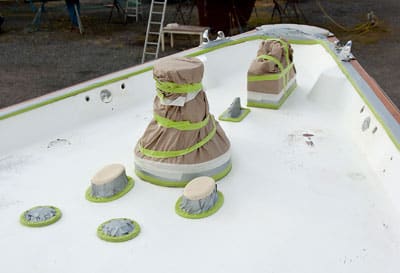
Next, to keep paint drips off teak handrails, the windlass, and the portholes, they masked these with heavy paper and tape. Right after the final wipe with a cleaning solvent, they took two days to roll and brush on two coats of epoxy primer, the base for the final topcoat. Over the next few days, the primed surfaces were sanded with 120-grit paper, followed again by vacuuming and hosing the resulting dust. Afterward, Janet cleaned all the surfaces with non-sticky tack cloths designed for multipart polyurethanes.
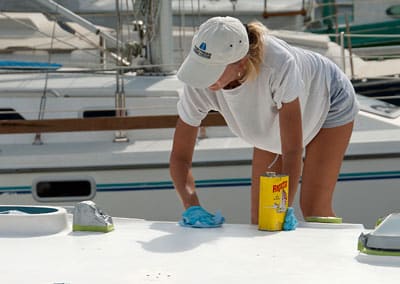
At this juncture, Steve identified and outlined the future nonskid areas, then spent a couple of days taping their inner edges with long-life 3M masking tape. At the corners, joining short lengths of tape on tight curves required meticulous care. After they wiped everything with cleaning solvent, they applied the first coat of multipart polyurethane to all the surfaces outside the future nonskid. Two more topcoat applications followed within allowable, 16-hour intervals. After sanding with 220-grit paper, dusting, using the tack rag, and wiping the solvent, they rolled and brushed on the fourth and final topcoat. The solvent-resistant, ultra-smooth, high-density foam-roller covers and quality brushes delivered the best finish. Working in the hot Florida sun required frequent additions of brushing reducer.
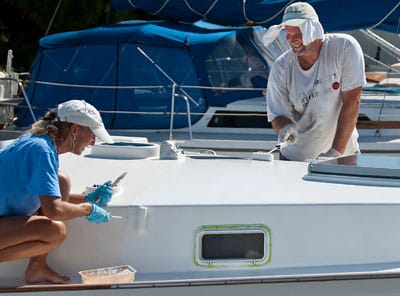
After allowing 48 hours to fully cure, they removed the masking tape. Fresh tape was then applied along the outside margins of the nonskid areas. All was ready for applying the nonskid coats. But first Steve spent a few days experimenting. He mixed his own color tints—too dark, and you couldn’t walk barefoot on the sun-heated deck; too white, and the deck glare was intolerable.
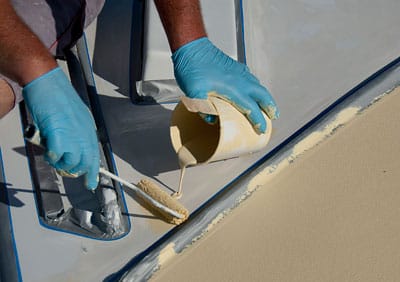
Also, he tested paint combined with various nonskid additives on scrap plywood; very coarse grit could damage human skin if a sailor knelt or fell on deck. He decided to combine equal amounts of coarse and fine grit. Significantly, this mixture prevented the coarse grit from settling down in the paint in lumps. On the big day, Steve and Janet mixed the activator with the paint base in a large container, added the correct nonskid grit, poured in the brushing reducer, and thoroughly stirred it all. After pouring small dollops within a taped area, Steve spread it out with a roller with Janet assisting, adding more paint or grit as necessary. She also wiped up Steve’s occasional paint drips with a solvent-soaked rag. The work went quickly and smoothly, though constant stirring of the paint/grit mixture was absolutely vital.
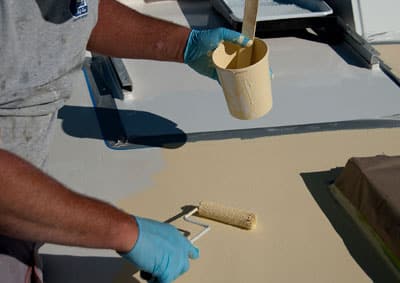
Twenty-four hours passed before heavy, late summer rain rolled in. By then, the paint had cured hard, and the coachroof was finished. They then repeated the whole operation to paint the deck. Nobody said rejuvenating a classic-plastic yacht would be quick or easy. But when the entire project was finished and Lunacy ‘s deck sparkled, the two sailors realized that all their meticulous efforts had been well worth it.
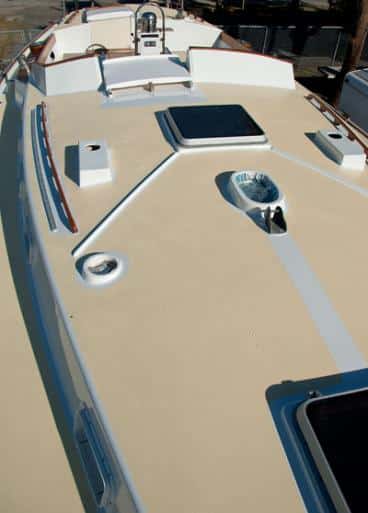
Steps:** 1. In preparation for the job, much of the deck hardware, including the stanchions, had to be removed. The remaining gear was carefully and completely covered and masked. 2. All the fastener holes were filled with silicon sealant, and the couple spent days grinding the old surfaces. Then Janet used a solvent wash to ensure a strong bond with the primer paint. 3. After dings and cracks were repaired and sanded, two coats of epoxy primer were applied. 4. Following another round of sanding, vacuuming, cleaning, and taping, the couple rolled and brushed on a fresh coat of Awlgrip topcoat. 5. After four coats of Awlgrip, it was time for the nonskid. First, Steve experimented with colors and grits. Once under way, he poured on a dollop of pre-mixed paint and spread it evenly. Note the paint stirrer, which was used to prevent the grit from settling. 6. Stirring frequently, to make sure the coverage was even in each masked area, Steve worked quickly and efficiently while Janet addressed small splashes with a solvent-soaked cloth. 7. Voilà! Once the masking tape was removed, the fresh decks fairly glistened.
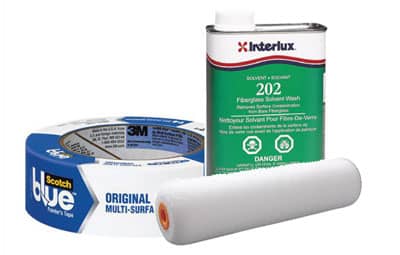
What You’ll Need: • Hook-and-loop sanding discs, sized to fit the sander pads • Sheets of sandpaper of grits 80, 100, 120, 180, 220, and 320 • 3M masking tape in widths of 1/2 inch (No. 256), 1 inch (No. 2090), and 2 inches (No. 225) • Gerson synthetic tack cloths • Roller frames and roller covers, with phenolic cores: ultra-smooth, high-density 4-inch and 6-inch roller covers (available from Home Depot; for the primers and topcoats) and Yellow stripe 3/8-inch nap (from West Marine; for the nonskid paint mixture) • Good-quality varnishing brushes • Cabisil (colloidal silica) thickening agent for making fairing putty with epoxy or polyester resin • Plastic putty knives • Interlux Fiberglass Solvent Wash 202 (for cleaning surfaces) • M.E.K. solvent (for cleaning all brushes) • Disposable paper/plastic pails of various sizes • A dozen wooden paint stirrers • Interlux Epoxy Primekote • Awlgrip topcoat (with Brushing Reducer and brushing converter) • Awlgrip Griptex nonskid additive (fine and coarse grades) • Ryobi and Makita random orbital sanders • Ryobi 6-inch palm polisher (used with a foam pad as a sander in complex spaces) • 3M breathing dust masks, ear protection, and solvent-resistant gloves
Longtime CW contributor Tom Zydler and his wife, Nancy, plan on spending this summer exploring the coast of Labrador aboard their Mason 44, Frances B .
- More: boat maintenance , How To , maintenance
- More How To

DIY Tips for Repairing Nonskid

Shaft Bearing Maintenance Tips

When the Wind Goes Light

How We Built Our Own Bulwarks

Hurricane Beryl Relief Efforts: How You Can Help

Gary Jobson To Talk U.S. Prospects in Upcoming World Sailing Competitions

For Sale: 2005 Tayana 48

Make Downwind Sailing Fun Again. Turn Off That Motor and Unfurl Your Kite!
- Digital Edition
- Customer Service
- Privacy Policy
- Email Newsletters
- Cruising World
- Sailing World
- Salt Water Sportsman
- Sport Fishing
- Wakeboarding

| Item | Frame | Qty | Price |
|---|
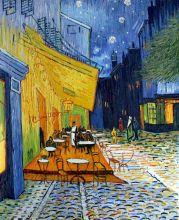
- Leonardo Da Vinci
- Amedeo Modigliani
- Edgar Degas
- Paul Cezanne
- Edward Hopper
- Johannes Vermeer
- Edouard Manet
- Rembrandt van Rijn

- Classic 20"x24"
- Square 24"x24"
- Small 8"x10"
- Oversize Paintings 36"x48"
- Large 24"x36"
- Extra Large 30"x40"
- Customary 16"x20"
- Miniature Pre-Framed Art

- Living Room Art
- Bedroom Art
- Dining Room Art
- Traditional Office
- Modern Office
- Family Room Art
- Lobby & Waiting Room
- Kitchen Art
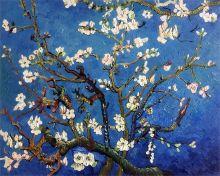
- Famous Cities

- Coastal Living

- Post-Impressionism
- Impressionism
- Expressionism
- Neoclassicism

- Glass Ornaments
- Ceramic Tiles
- Miniature Framed Art
- Coconut Bowls
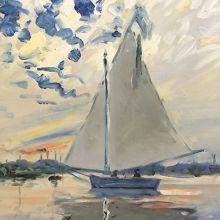
- Gifts for Wife
- Gifts for Husband
- Gifts for Newlyweds
- Gifts for Son
- Gifts for Grandma
- Gifts for Grandpa
- Gifts for Sister
- Gifts for Friends
- Gifts for Daughter
- Best Sellers
- New Arrivals
Harbor Scenes & Boat Oil PaintingsBrowse famous paintings by artists Claude Monet , Winslow Homer , William Bradford , Vincent Van Gogh and Edward Hopper . Our sailboat paintings include scenes from New England to tropical islands. Depending on the mood you want to set, choose a painting that contains darker, more ominous colors for a New England, stormy feel, or transform a boring room into an upbeat tiki scene with bright colors and beautiful boats. 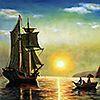 Oversized 36" X 48" $169.50 Classic 20" X 24" $189.00 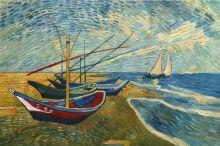 Small 8" X 10" $99.00 Customary 16" X 20" $149.00 Large 24" X 36" $249.00 Extra Large 30" X 40" $399.00 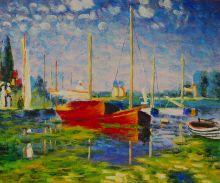 Classic 20" X 24" $199.00  Small 8" X 10" $39.00 Customary 16" X 20" $69.00 Classic 20" X 24" $99.00 Square 24" X 24" $119.00 Large 24" X 36" $149.00 Extra Large 30" X 40" $179.00 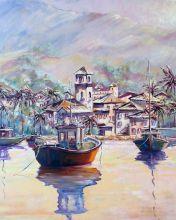 Beautiful Boat Scenes These paintings of boats have been created to meticulously reflect their originals. Hang them in your home, your beach house or lake cottage and enhance their ambiance. Order recreations of famous paintings like Red Boats at Argenteuil , Boats at St. Marie's and A Sunset Calm In the Bay of Fundy . HAPPY ART CUSTOMERS save 20% instantly and never miss a dealOrder toll free.
Business & trade
CUSTOMER SERVICE
Get 6 Months to pay on $99 or more Check out with PayPal and choose Bill Me Later Subject to credit approval. US customers only.
Disclaimer: www.overstockart.com is not affiliated in any way whatsoever with Overstock.com, Inc. or with www.overstock.com Your feedback is very important for overstockArt.com, so we could be even better.
9 Paintings by Claude Monet You Should KnowClaude Monet is considered the father of Impressionism. He made roughly 2,000 paintings that are now the subject of fascination for people around the world.  Claude Monet is most renowned for his series of paintings, including Water Lilies, Haystacks, and Rouen Cathedral . Nonetheless, the artist produced hundreds of other singular artworks that confirm his role as the most consistent member of the Impressionist art movement. By observing the colors he used and how he applied them, as well as his composition plan, we can understand how Monet’s artistic style evolved. Get ready to step back into 19th-century France and the universe of Claude Monet’s Impressionism. 1. Impression, Sunrise by Claude Monet One cannot discuss Claude Monet’s art without looking at Impression, Sunrise , one of his most notable pieces. Not only was it the centerpiece of Impressionism in terms of technique, but it also served as inspiration for the term Impressionism itself. It was this painting’s title that prompted Louis Leroy, an art critic, to use the word Impressionists when referring to the artists who participated in the 1874 exhibition. Although Leroy did not positively use the term, both the painters and the audience adopted it to describe the style. Ultimately, Impression, Sunrise became the starting point of Impressionism. So, what is it that makes this painting such a pivotal piece in the development of this movement? First, it was executed en plein air , a technique preferred by the Impressionists. Secondly, the paint was applied in loose brushstrokes, which captured the impression of a fleeting moment. The work is painted in an almost abstract way, which made it look unfinished at the time. 2. Woman With a Parasol Get the latest articles delivered to your inboxPlease check your inbox to activate your subscription. Monet’s Woman with a Parasol captures Camille and Jean Monet, his wife and son, going for a walk. Like other artworks signed by the artist, Woman with a Parasol is an excellent embodiment of the way Impressionists experimented with light, shade, and color. In addition, this particular painting depicts the playful nature of the wind, which can be noticed in the waving grass and Camille’s dress. The work has a strong upward perspective, with the sky and the clouds making up most of the background. The bright and vivid colors are applied in spontaneous, animated brushstrokes, thus providing the painting with a casual touch. 3. The Magpie Out of roughly 140 snowscapes signed by Monet, The Magpie is probably the most famous one. It is also the largest snowscape he ever painted. The painting was executed in the winter of 1868. At the time, Monet was in Normandy, near Étretat, where Louis Joachim Gaudibert, his patron, helped him find a house where he could raise Jean, his newborn son. The Magpie is a representation of Monet’s masterful recreation of sunlight and shadows. We see a magpie perched on a gate with its back to the sun, which shines upon the snow. Traditionally, shadows are painted using black colors. Here, however, one can observe a slightly colored, bluish shadow on the snow. Monet relied on the effect produced by the blue-yellow complementary colors, which, combined with short brushstrokes, created an effect of bluish-violet shadows. This method would later become a typical impressionist way of portraying the changing nature of light. 4. The Woman in the Green Dress The Woman in the Green Dress is also known as simply Camille . It was executed in 1866 and it shows Monet’s future wife wearing a long, green, black-striped dress and a furry, black jacket. She is also shown wearing yellow leather gloves with her hair tied in a bun. Although it seems like a typical portrait at first, one can notice that just like in Woman with a Parasol, Monet tried to depict a fleeting, casual moment. First of all, we cannot see the dress fully, as it’s cut on the left edge, thus creating the impression of movement. The folds of the dress suggest liveliness as well. Camille has her head slightly turned backward and looks downward as if she were contemplating something. Unlike his later works associated with Impressionism, The Woman in the Green Dress was well received by the public and the critics. People were happy with such a portrayal of a fashionable woman. 5. Garden at Sainte-Adresse Garden at Sainte-Adresse was finished in 1867 and exhibited at the 4th Impressionist Exhibition in 1879. It shows the garden in Sainte-Adresse overlooking the English Channel with the Honfleur commune on the horizon. Once again, the viewers can notice the creative play of light and shadows. However, the figures are depicted quite realistically and in detail, which isn’t typical of his later works. Nonetheless, we can still see the vibrant colors of the flowers applied in short brushstrokes. Garden at Sainte-Adresse often comes up when we think of the influences of Japanese wood prints on Impressionism. Pierre-Auguste Renoir actually called this particular artwork the Japanese painting . It is thought to have been inspired by the Japanese print called Turban-shell Hall of the Five-Hundred Rakan Temple by Hokusai. The influence can be seen in three horizontal plans of the composition, which appear to be parallel rather than depth-induced. 6. La Japonaise La Japonaise shows a European woman (Monet’s wife Camille) wearing a red Japanese kimono. She holds a hand fan and stands on a tatami mat in front of a wall covered in Japanese fans. Camille has her head turned toward the viewer, an element inspired by Japanese dance. But hers is not the only face we see in this painting since the red kimono contains the face of a samurai . After his son was born, Claude and Camille were in great financial trouble, so executing and selling a painting with Japanese elements seemed like an excellent idea, considering the popularity of Japonisme in France at the time. However, what began as a simple way of earning some money turned into a superb experience for the artist. Shortly after he began working on the painting, Monet realized what a pleasure it was to paint detailed kimonos. After La Japonaise was put on display at the 1876 Impressionist Exhibition, many critics pointed to its erotic symbolism. More precisely, they discussed the placement of the samurai’s head, as well as the woman’s flirty facial expression. Apparently, Monet was embarrassed by the effect the painting had on the audience. He allegedly withdrew the painting from the exhibition himself and told people that it was sold to an anonymous buyer. 7. The Studio Boat Did you know that Monet bought a boat (that soon became his studio) so that he could experience the en plein air painting technique to the fullest? Well, in The Studio Boat , Monet portrays himself working in his remote working place—the boat floating on the Seine. Although Monet made several other paintings featuring his studio boat, this one has been of particular interest to critics. It pointed indirectly to the fact that Monet was slowly alienating himself from portraying urban industrial scenes. 8. The Artist’s Garden at Giverny Claude Monet was very passionate about gardening, and his estate in Giverny became his heaven in this regard. He spent years and years caring for his garden and, at the same time, depicting it on hundreds of canvases. Therefore, we cannot neglect this iconic painting, which transposes how much love Monet put into cultivating his Giverny garden. In fact, the garden still exists and it welcomes thousands of visitors every year. Monet was 60 years old when he painted The Artist’s Garden at Giverny. The painting depicts diagonal rows of brightly colored irises and you can almost see the flowers moving in the wind. He executed it the same year he started working on his most famous series, Water Lilies . 9. Rough Weather at Étretat by Claude Monet Although not as famous as his Water Lilies series, Monet showed a particular interest in seascapes, which seem to have been executed at least partly on the beach. Imagine that even Rough Weather at Étretat was probably painted right on the spot, despite the bad weather. Art specialists found a grain of sand embedded in the paint surface, which is direct proof that that particular paint was applied on the shore. In Rough Weather at Étretat , Monet focused on emphasizing the magnificent strength of nature. He applied colors in loose brushstrokes aimed, outlining a fleeting moment when big waves strike.  How Did Claude Monet Capture the Passing of Time? By Mihaela Gutu MA Literary Translations, BA EN/DE Language and Literature Mihaela is a freelance writer, editor, and translator. She’s an avid reader of classic literature with a background in literary studies and literary translations. She is obsessed with language grammar and syntax, so spending hours dissecting sentences and texts is a pleasure for her. Mihaela grew up in a family full of artists. Although she pursued a career in literary arts, she’s also passionate about performing arts (particularly dance) and visual arts. In her free time, Mihaela plays with her cat Cappuccino, binge-watches TV series, rereads her favorite books for the tenth time, and spends time online learning new stuff.  Frequently Read Together Claude Monet: Get to Know the Father of Impressionism How Did Japanese Art Influence Impressionism? 5 Key Motifs in the Art of Pierre-Auguste Renoir12 things to do in Dallas County this weekend include Cardboard Boat Regatta, Waukee Arts FestivalTerrific turtles. 9-10 a.m. Thursday, July 18 at Voas Nature Area, 19286 Lexington Road, Minburn. Ever seen a turtle up close? Would you like to? Join DCCB at Voas Nature Area to learn about wild turtles, meet our education turtle, and learn how you can help them cross roads. This is a live animal program. Health & Wellness Night4-7 p.m. Thursday, July 18 on 2nd Street, Perry. Join us for the Perry Farmers Market from 4-7 p.m. every Thursday, but especially on the Third Thursday of the month for special events! Thursday, July 18 is Health & Wellness Night at the 2024 Perry Farmers Market. In addition to regular market vendors with their abundant fresh produce, various special guests will be joining us to help you feel a bit more healthy and well. Special guests will include Perry New Opportunities, Dallas County Health Department, Perry Lutheran Homes and ISU Extension. Look for more information on the Perry Farmers' Market Facebook page . Perry's 2nd Street Block Party5-10 p.m. Friday, July 19 on 2nd Street, Perry. Join the Perry Chamber on Friday, July 19 for the 3rd Annual 2nd Street Block Party in Downtown Perry with live music by Oreo Meatwagon Trio. 2nd Street will be closed between Lucinda and Warford Streets for a street dance. The event entrance will be located at the intersection of Warford & 2nd Streets, with the band set up near Lucinda Street in front of Ben's Five & Dime. Come on out and join the Perry Chamber for an evening full of fun! Admission will be taken at the entrance and must be 21+ to enter. Proceeds support the Perry Chamber of Commerce. Cardboard Boat Regatta6 p.m. Friday, July 19 at Adel Family Aquatic Center. Gather your crew, build your ship and race across the high seas of the Adel Family Aquatic Center on Friday, July 19. Boats arrive at 5:30 p.m. and the races will follow at 6 p.m. Come up with a theme and get creative - dress the part! Awards will be given to the top finishers as well as special awards for best design, best theme, most epic sinkage. For complete rules and to register, go to adel.activityreg.com . Waukee Arts FestivalJuly 19-20 at Centennial Park, Waukee. See artist exhibits and listen to live music at the two-day Waukee Arts Festival. The festival opens at 5 p.m. on Friday, July 19 with artist vendors, food trucks, beer garden and live music. Artist vendors will be open from 5-9 p.m. on Friday. The festival reopens from 10 a.m. to 10 p.m. on Saturday, July 20 with daytime music, art vendors, food trucks, beer garden, kids activities and evening concerts. Artist vendors will be open from 5-9 p.m. July 19 and 10 a.m. to 6 p.m. July 20. The 1st Annual Waukee Fine Arts Footrace 5k will be held at 7:30 a.m. on Saturday, July 20. Sign up for the race at runsignup.com/Race/IA/Waukee/WaukeeFineArtsFootrace . Saturday's activities will also include yoga for adults and kids, balloon animals, kite building and a magic show. For more information, visit the Waukee Arts Festival 2024 Facebook event, Waukee Area Arts Council Facebook page or waukeeartsfestival.org . Outdoor Summer Movie8:30 p.m. Friday, July 19 at 2200 Walnut St., Granger. The Granger Parks & Recreation Department will continue its outdoor summer movie series with "Elemental" on Friday, July 19. The movie will be shown on the north side of the Community Center on the grass. Popcorn and candy will available for purchase. Upcoming movies include "The Super Mario Bros. Movie" on Aug. 23. Granger Yoga in the Park8-9 a.m. Saturday, July 20 at Centennial Park, Granger. Join Jessica for Yoga in the Park on the following dates: July 20 & 27; Aug. 3, 10 & 17. Bring a towel or yoga mat. Yoga in the Park is a free program that is open to all ages. 8-10:30 a.m. Saturday, July 20 at Voas Nature Area19286 Lexington Road, Minburn. Summer birding can be challenging with many birds going silent on the nest. By mid-July many of the young are fledging which makes them conspicuous as they beg for food and learn to fly. We will bird the main park as well as caravan to the Wetland Mitigation Bank. Some binoculars and bird books will be available. Registration is required through DCCB's Eventbrite page . Van Meter Yoga in the Park8:30-9:30 a.m. Saturday, July 20 at Trindle Park, Van Meter. Van Meter Parks & Recreation is sponsoring yoga this summer. Please note the new location, if we have rain, we can still practice under a shelter. Bring a beach towel or yoga mat and join us as we move our bodies in the outdoors. This practice requires the ability to get up and down off the ground. Yoga in the Park will be held on July 20 and Aug. 3. Household Hazardous Waste Drop Off9 a.m. - 12 p.m. Saturday, July 20 at Perry Police/Fire Station parking lot, 908 Willis Ave. Dispose of your hazardous waste safely! On Saturday, July 20, head to the Police Station/Fire Station parking lot. Bring your old paint, batteries, cleaning chemicals, and other hazardous materials. This event is free and for Perry residents. New this year, the Legacy of Christopher Allsup Gas Can Exchange Event will be held during the Household Hazardous Waste Drop-Off. There will be 50 gas cans to giveaway this year. First come first served, and limiting one can per household! For more information, call 515-333-4432. Annual Tire Drop-Off9 a.m. - 12 p.m. Saturday, July 20 at Perry Recycle Center, 14325 Ivy Place. Got old tires cluttering your garage? No worries! The city of Perry is hosting a Tire Drop-off event at the Perry Recycle Center. Bring up to five car tires for free disposal. A cost of $5 will be charged to dispose of each additional car tire. The disposal cost for semi tires is $10 and tractor tires will be $20 each. Clear out your space and keep our streets clean! Art in the Park10 a.m. - 12 p.m. Saturday, July 20 at Johnson Park, Van Meter. Join Van Meter Parks & Recreation for Art in the Park on Saturday, July 20. Parks & Rec will supply all you need to make a homemade windsock! Construction paper, streamers, stickers, glue, etc. This is a no-cost event to the participants sponsored by Parks & Recreation. There is a free-will offering if so inclined. Greater Des Moines Community Band Outdoor Concert7 p.m. Monday, July 22 at Perry Lutheran Homes Eden Acres Campus, 1300 28th St., Perry. Join Perry Lutheran Homes residents and staff for live music as it hosts the Greater Des Moines Community Band on Monday, July 22. The concert, which is open to everyone, will be held in the east parking loop at the Eden Acres Campus. Hamburgers, hot dogs and drinks will be available to purchase. Bring a chair or blanket for your seating comfort. Senior Expo10 a.m. - 2 p.m. Wednesday, July 24 at Dallas County Hospital South Atrium. Dallas County Hospital departments will be present and sharing information, along with over 20+ other healthcare entities who will also be exhibiting and many will have their own giveaways during the Senior Expo. There will be a few companies selling merchandise. A variety of classes and bingo games will be available. Blood pressure checks can be performed by nursing students. Each attendee will receive a bingo card with exhibitors' names in each square to sign-off on, and a completed card will earn you entry for some great prizes. Snacks will be available while supplies last. The event is free, and local seniors are encouraged to take advantage and spend an hour, or the full four hours, at the expo. Please take advantage for your health, and to ensure the sustainability of this effort into the future. Free Merchant Movies11 a.m. Wednesday, July 24 at Perry Grand 3 Theatres. The Perry Grand 3 Theatres will continue the 2024 summer movies on Wednesday, July 24 with "The Bad Guys." All movies will be shown at 11 a.m. on Wednesdays through Aug. 7. Admission is free thanks to local sponsors. Look for a full list of upcoming movies on the Perry Grand 3 Theatres Facebook page . Community Health and Job Fair3-5 p.m. Wednesday, July 24 at McCreary Community Building, 1800 Pattee St., Perry. Iowa Total Care along with Iowa Workforce Development are presenting a Community Health and Job Fair on Wednesday, July 24. This event will include free produce, non-perishable food items, health, and job-related resources at the McCreary Community Building. The Iowa Workforce Mobile Employment Center will be onsite to help attendees with all their employment related questions. 9-10 a.m. Thursday, July 25 at Kuehn Conservation Area, 32828 Houston Trail, Earlham. In this scavenger hunt meets I Spy, come out and walk around the upper area of Kuehn searching for hidden animal furs. Learn about these animals, go at your own pace, and enjoy a summer day at a beautiful park. This is a self-guided hike; a naturalist will be there to get you started and answer questions during the time of the program. Pollinator Palooza12-3 p.m. Friday, July 26 at The Brenton Arboretum, 25141 260th St., Dallas Center. Join The Brenton Arboretum, The Blank Park Zoo and Iowa State as we celebrate pollinators, conservation and the wonderful outdoor world. The Brenton Arboretum is excited to welcome guest Ben White from Blank Park Zoo from 1-2 p.m. on Friday, July 26. Ben will present an interactive class for all ages about what to plant and grow in your yard for all those wonderful bugs, insects, birds and butterflies that are native to our area. Ben will also have a selection of animals from Blank Park Zoo to help with our program. Iowa State will have their Conservation Station set up from 12-3 p.m. Various games and activities will be hosted by The Brenton Arboretum between 12-3 p.m. All programs are free and open to all ages. Kid's Market5:30-7:30 p.m. Friday, July 26 at 5th Quarter Bar & Grill, Van Meter. 5th Quarter will host its first Kid's Market on Friday, July 26. Youth, 17 and under, will set up their own booths/tables to offer their products to the public. Come out & support our young entrepreneurs! Parents: Register your child(ren) and concept using this form link: forms.gle/1WB8fFqNyfTh3HhG8 . Registration deadline is Tuesday, July 23. Mobile Food Pantry8:30-10:30 a.m. Saturday, July 27 at Crossroads Church, Perry. Crossroads Church will host a mobile food pantry from 8:30-10:30 a.m. on Saturday, July 27. To submit events to be included in the Around the County round-up, email [email protected] or [email protected]. Opinion It’s never too late to keep bees, build a sailboat or become an artistPost readers on the skills they always wanted to have, and finally got brave enough to pursue. Former House Democratic whip David Bonior recently wrote about learning to play the piano in his late 70s. We asked Post readers about things they had always wanted to try and the strategies that helped them develop new skills. At age 10, I saw an observation beehive and was fascinated. I didn’t get my first hive until 2020, when I was almost 65. Four years later, I’m still learning, and I will keep doing so right up to the moment when I have to give it up. I’m in the Oregon Master Beekeeper Program . My six colonies all came through last winter. The book learning, observational learning and physical challenges of beekeeping invigorate my life — and regular inspections of my hives add a nice little frisson of danger. My husband and I, and a few neighbors, greatly enjoy the best honey we’ve ever had. Diana Dickinson , Portland, Ore. I was a literature major in college, but did poorly in poetry and ignored it all of my adult years. Just before the pandemic, I asked to tag along to a friend’s poetry group and immediately became hooked. Together, we’ve explored both traditional and modern poetry and come to love and feel at home in a variety of forms. Meeting online during the pandemic kept us all from being bored at home; now we meet in each other’s homes biweekly to spend two hours immersed in a new poet or style. This practice has constantly challenged our knowledge of history, literature, geography, science — you name it. And of course, we’ve all become close friends. Today I count poetry, along with the group that brought me to it, as one of the chief joys of my retirement years. Jean Thayer , Arvada, Colo. I’ve been a sailor most of my life, first on my father’s boats and later with power boats for my own kids. A few years back, I bought a classic cruising sailboat to use near our home on Buzzards Bay in Massachusetts. The bay isn’t known for calm water and is often a challenge in the afternoon. I hoped my wife would come to share my enthusiasm, but when that didn’t happen, I sailed solo for several years. When you are sailing solo far from shore, one minor mistake can put you in serious hot water, which wouldn’t necessarily happen if there were a second set of hands on board, as my wife started to remind me around my 75th birthday. A fork was starting to appear in the road ahead. I’m a pretty good carpenter, and wooden boats always held interest. I attended several classes at the WoodenBoat School in Maine and started to feel a major pull toward building. As I write this, a new 17-foot sailboat is under construction in my garage, and the cruiser’s new owners are hopefully making the same discoveries that delighted me a few years ago. My wife is relieved, despite the sawdust on her car. And I am using a new set of skills that otherwise would have gone to waste. Rob Hill , Westport, Mass. After my husband died about 10 years ago, I needed to do something that would occupy my mind and thoughts. So I started singing. I joined a local chorus and realized that most of the chorus members had sung in church or with other choruses. I had never sung with any group and needed help. I found a wonderful voice teacher, who has become my coach, cheerleader and wonderful friend. But every year, she has required her students to do solos in front of a small group. This has terrified me for 10 years, but I am slowly becoming more confident, even though I always feel that I mess up. Now I belong to two choruses, including a wonderful gospel group. I volunteer weekly to sing with a small group for dementia patients. They are so appreciative and nonjudgmental. Singing wonderful music has been challenging and stressful, but it has really enriched my life. Am I Barbra Streisand? No, but I am making progress! Janet Feder , Mundelein, Ill. I have made a career in music, as a musicologist, but only late in life turned to the instrument I have always loved, the flute. I was too afraid that sounding like a beginner would damage my credibility as a writer of music. Finally, I took the plunge, and it has been both satisfying and humbling. Learning a new skill at my age is not the same as learning it as a child or young adult. After declining to play in a couple of recitals, I finally played for the first time in a recital in front of my colleagues, friends and students. Was I crazy exposing myself like that? The flute demands not only coordinated finger work but also great breath control and a loose throat, none of which my nerves allowed. Somehow I got through the piece, the Sarabande from Bach’s Partita in A Minor. I was disappointed and elated. I did not sound like I wanted to, but most important, I did it. And my friends, colleagues and students were all too kind; they were with me and supportive. I continue to study. Will I ever get where I want to be? The pace is glacial, another product of starting late. But while it does remind you of the reality of your age, the slow progress and small victories also remind you that challenges can be overcome regardless of how old you are. Michael Broyles , Tallahassee As a freshman at City College of San Francisco in 1947, I signed up for architecture, interior decorating and art classes. During my first art class, which involved sketching furniture, the teacher told me to drop out and take a simpler class. I was embarrassed, to say the least. Later, my mother-in-law was an artist, followed by my two daughters, and I was intimidated to even think I could learn to paint a straight line. But now, at age 94, I have become a true artist! A local art teacher is giving acrylic painting classes once a month, and I started eight months ago. I was so excited with the results of my first piece. My family provided me with supplies to paint for months. My second bedroom is now my studio. Beverly A. Moglich , Bend, Ore. When I was growing up in the late ’60s and early ’70s, my parents allowed me one after-school activity. I wanted to play the piano. But I did want to learn to paint, too. I loved going to art museums to gaze at the masterpieces by Claude Monet, Vincent van Gogh and Camille Pissarro, among others. Time passed, and I was raising a family and working. There was little time for myself. Now that I am retired, I decided to take a big jump and learn to paint. I found a class at my local community college, and I signed up. I was incredibly apprehensive. Was this a class for a beginner? Did I need some background knowledge? Would I be able to do this? Before the class began, I emailed the instructor, and she told me not to worry. As it turns out, my new hobby is bringing out my creativity. Plus, I find it calming. Best of all, I am having fun. I met lovely fellow artists, and I am learning from them, too. I will never become a great painter, but I’m having a blast trying! Theresa Wiecezak , New Hyde Park, N.Y. I’m a social worker and former singer, and I’ve always wanted to play the piano like a concert pianist. However, I live with learning disabilities, and one of them, unfortunately, is that my left hand and my right hand don’t like each other. I’ve tried piano lessons various times in my life but only met with disappointment, failure and shame. As one piano teacher said to me, “You have such long fingers. Too bad you can’t play piano.” However, as an octogenarian, I found a piano teacher who can deal with my obstacles. I, like David Bonior, was in a piano recital with a bunch of children who played much better than I did. But people can be nice to old ladies, and I was received with warmth by a gracious audience. I guess exposing one’s frailties in the right context can have some benefits. Myrna Orenstein , Evanston, Ill. I’ve been an active musician since high school, playing saxophones, flute and clarinet. My favorite setting is the jazz ensemble, and I currently play baritone sax in a local group. As I approached retirement in my government contractor job, I knew music would play an even larger role in my life. At age 62, I studied a textbook on jazz ensemble arranging and started writing “charts.” Finally, I could stop complaining about deficiencies in other people’s charts and start writing my own, based on decades of experience. I’m now 69 and retired and have written nearly 30 charts, most of which have been published and performed. My lifetime goal is at least 100 charts. One of the beneficial side effects is that the mental discipline of writing music makes me a better player on all of my instruments. As legendary cellist Pablo Casals is said to have remarked when asked why he still practiced daily at age 80: I think I’m making progress. James Vedda , Alexandria About letters to the editorThe Post welcomes letters to the editor on any subject, especially those that expand upon the ideas raised by published pieces and those that raise valuable questions about The Post’s practices and choices. Letters should run no more than 400 words, be submitted only to the Post and must be published under your real name. Submit a letter .   |
IMAGES
VIDEO
COMMENTS
Choose your favorite sailboat paintings from 23,599 available designs. Featuring all kinds of sailboats, from sloops to schooners and yachts to yawls, this collection of paintings has something for everyone. These pieces of art invoke deep emotion with pictures of stormy weather, sleepy harbors and majestic, three-masted ships. With so many different styles and motifs to choose from, sailing ...
In today's acrylic painting tutorial we paint a sailboat out on the ocean at sunset. This relaxed painting lesson is done in real time and will cover the ste...
Hello my creative friends! In this acrylic painting tutorial we will go step by step to learn how to paint a sailboat in the ocean. Thank you to my awesome p...
Crepin's painting portrays, with great accuracy, the close-quarters combat that so often occurred in naval battles. 4. Snow Storm - Steam-Boat off a Harbour's Mouth - J.M.W Turner. As noted above, J.M.W. Turner was among the most famous artists who focused on the life and voyages of sailors and their ships.
In today's acrylic painting tutorial we paint a seascape depicting a sailboat out on the reflective water. This relaxing painting lesson is completed for the...
Sailboat painting has a long-standing tradition in maritime culture. In the past, sailors used a mixture called "ship paint" consisting of tar and natural materials. This protected the boats from rot and deterioration and improved their performance in the water. Nowadays, sailors have a wide range of primers and paints designed specifically ...
Whether you are looking for an original Sailboat painting or a high quality art print, Saatchi Art has over 984 original Sailboat paintings for sale from emerging artists around the world. Clear All. Sailboat. 4426 Dusk at the Nile river - sunset. Paintings , 11 W x 7.9 H x 0.1 D in.
Edouard Manet's Boating is a masterpiece of Impressionism that captures the joy and freedom of a summer day on the Seine. The painting depicts a couple in a sailboat, with the woman wearing a striking white dress and hat. The Metropolitan Museum of Art offers a detailed analysis of the painting's composition, style, and context, as well as its relation to other works by Manet and his ...
Whether you are looking for an original Sailboat painting or a high quality art print, Saatchi Art has over 460 original Sailboat paintings for sale from emerging artists around the world. Clear All. Sailboat. Oil. 4426 Dusk at the Nile river - sunset. Paintings , 11 W x 7.9 H x 0.1 D in.
Sailboat Painting Blue Ocean Oil Painting on Canvas Original Ship Art Seascape White Blue Painting Nautical Painting Sailing Boat Wall Art. (187) $529.60. $662.00 (20% off) FREE shipping.
Blocking in the background is an important step in painting a sailboat with acrylics. It establishes the composition and sets the tone for the rest of the painting. Here is a step-by-step guide on how to block in the background: 1. Choose the colors for the background based on the atmosphere and mood you desire.
Paintings of Sailboats. Ali Wisch. Updated: Aug 2, 2017. Original: Dec 15, 2016. With water covering nearly seventy-one percent of the earth's surface, it is no surprise that people have been portraying the sea through marine art since prehistoric times. There are many marine artists who are keeping this tradition alive: here are six of them.
After you have finished with the 600 grit sandpaper, it is time to move on to 800, then 1200. This process is important so you will be painting on as smooth a surface as possible. It is then a good idea to wipe the surfaces of the boat down with a damp cloth to remove any of the dust and flakes of metal/wood.
Practical Steps for Painting a Sailboat. Step 1. Give the sailboat a thorough cleaning. Step 2. Start sanding the hull's surface. Step 3. Prepare the primer, then apply it. Step 4. Prepare the paint, then start applying the topcoat and antifouling coat.
Sky and water are dappled, and the boats are appear bunched together as they move gracefully along the river. All this gives the painting a peculiar kind of vitality and charm. Le Havre, Fishing Boats Leaving the Port, 1874. Claude Monet (1840-1926) Courtesy of Wikimedia Commons. It's a wet morning, but a crowd has gathered on the ...
Learn how to paint a sailboat scene in this, step by step, acrylic painting tutorial with artist Ashley Krieger. This lesson will teach you the steps to take...
Whether you have a sailboat, powerboat, or kayak, the principles of boat painting remain largely the same. Assessing your boat's condition. Before you begin, evaluate your boat's current condition. Inspect the hull for any damage, scratches, or rust that may need to be addressed before painting. Make a list of necessary repairs and tackle them ...
Sailboats. Paintings , 59.1 W x 39.4 H x 0.6 D in. Shahid Zuberi. United Kingdom. $15,750. Prints from $70. Landscape with a Sail Boat. Paintings , 3.8 W x 5.1 H x 0.1 D in. Vita Schagen.
Browse 2,457 sailboat paintings photos and images available, or start a new search to explore more photos and images. under sail - sailboat paintings stock illustrations. Under sail. marine painting, dutch botters on the scheldt, 19th century - sailboat paintings stock illustrations.
Fishing Boats on the Beach at Saintes-Maries (1888) by Vincent van Gogh; Vincent van Gogh, Public domain, via Wikimedia Commons . Warship and sailboat paintings have always been popular subjects. This is likely due to the fact that ships have played such an important role in the development of civilization.
Painting a sailboat Tom Zydler. Janet Van Leuwen and Steve Van Wig own a Whitby 42. Looking at their beautiful, well-groomed ketch, you'd never guess it was built in 1982. The name on the stern, Lunacy, may be the only hint of the incredible amount of work that the couple has put into rejuvenating their boat. Bringing the decks and the ...
Mar 27, 2020 - Explore Modern Art Gallery's board "sailboat painting", followed by 1,594 people on Pinterest. See more ideas about sailboat painting, painting, canvas painting.
Harbor Scenes & Boat Oil Paintings . Browse famous paintings by artists Claude Monet, Winslow Homer, William Bradford, Vincent Van Gogh and Edward Hopper. Our sailboat paintings include scenes from New England to tropical islands. Depending on the mood you want to set, choose a painting that contains darker, more ominous colors for a New ...
The Studio Boat by Claude Monet, 1876. Source: Barnes Foundation, Philadelphia Did you know that Monet bought a boat (that soon became his studio) so that he could experience the en plein air painting technique to the fullest? Well, in The Studio Boat, Monet portrays himself working in his remote working place—the boat floating on the Seine ...
Race cardboard boats, listen to live music during a block party, check out an arts festival, watch an outdoor movie, go on a bird hike, enjoy art in the park and more.
The festival will screen "Guardians of the Galaxy 3" Thursday at 9pm, with viewers welcome to watch from the lake on their boats (not provided). Free; 🎨 The Minnehaha Falls Art Fair, one of the biggest art fairs in the state, is Friday-Sunday and features over 175 artists throughout the south Minneapolis park. Bonus: Every vendor will have ...
As I write this, a new 17-foot sailboat is under construction in my garage, and the cruiser's new owners are hopefully making the same discoveries that delighted me a few years ago. My wife is ...